Reptiles and Amphibians of Coastal Southern California

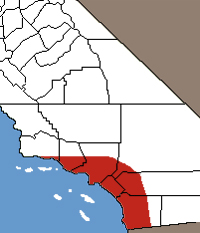
Area covered here is marked in red
.

| These are the native and well-established non-native reptiles and amphibians that inhabit Coastal Southern California, which for our purposes includes the transverse and peninsular mountain ranges and the land interior to the sea, including the Santa Monica mountains, the San Gabriel mountains, the San Bernardino mountains, the San Jacinto mountains, and the Santa Ana mountains. This includes parts of Los Angeles, Orange, San Diego, Riverside, Ventura, Santa Barbara, and San Bernardino counties, excluding all desert regions. Not every animal shown here is present in every part of the are covered here. Look at the range map and the description for each species for a better idea of where it occurs. Click on the Latin name link to see more pictures, videos, and information about a particular animal. |
|||||||||
|
|||||||||
| Snakes | |||||||||
Most snakes in coastal Southern California are active during warm and sunny weather, typically from late February through October, and remain underground at other times. They become active later at higher elevations, and go underground sooner. |
|||||||||
| San Diego Gophersnake Pituophis catenifer annectens |
|||||||||
| Not Dangerous to Humans | |||||||||
|
Videos |
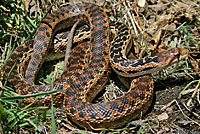 |
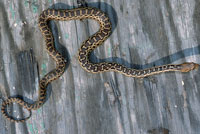 |
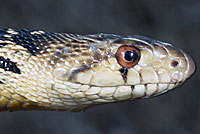 |
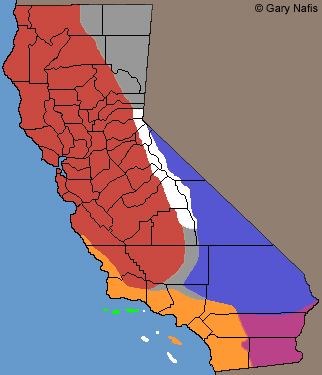 Range shown in Orange and Gray |
|||||
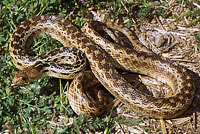 |
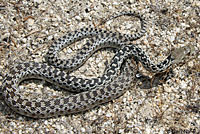 |
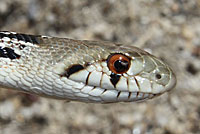 |
|||||||
| Adults are typically 4 to 5 ft. long. Hatchlings are around 15 inches long. A large, thick bodied, slow-moving snake with a head slightly wider than the neck and large rough scales. Brown or tan with dark markings on the back and often reddish coloring. |
Diurnal. Nocturnal on hot nights. Probably the most commonly seen snake in our area. Found in many habitats - grassland, chaparral, agricultural, riparian, woodlands, desert, from sea level to the mountains. |
Eats mostly small mammals, birds, eggs. Females lay eggs June to August. Young hatch August to October. Often confused with rattlesnakes, but the tail is long and thin with no rattle. See here. |
|||||||
| California Kingsnake Lampropeltis californiae (formerly Lampropeltis getula californiae) |
|||||||||
| Not Dangerous to Humans | |||||||||
 |
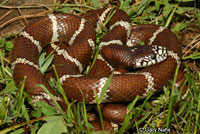 |
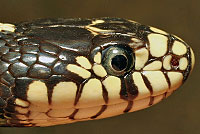 |
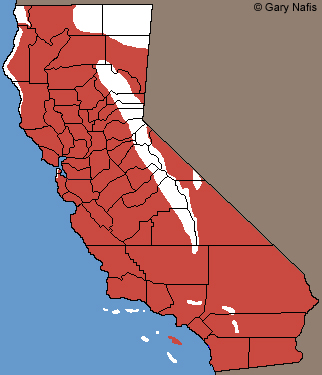 Range shown in Red |
||||||
|
Videos |
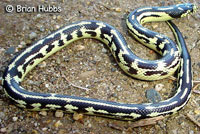 |
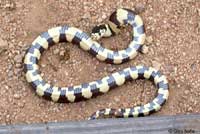 |
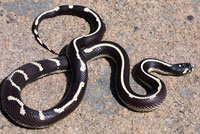 |
||||||
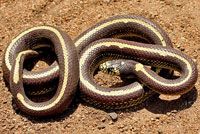 |
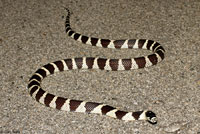 |
 |
|||||||
| Adults are typically 3 to 4 ft. long. A large, thick bodied, slow-moving snake with a head slightly wider than the neck and smooth scales. Black or brown with light bands circling the body. Striped and banded/striped forms also occur. This snake is highly variable in appearance, especially near the coast. The underside is light in color. The dark bands continue around onto the underside. |
Diurnal and Nocturnal. Common. Found in a wide range of habitats: forest, woodland, chaparral, grassland, wetlands, agricultural land, deserts, brushy suburban areas, from sea level to mountains. |
Eats small mammals, lizards, snakes (including rattlesnakes) eggs, frogs, birds, and large invertebrates. Females lay eggs May to August. |
|||||||
| California Striped Racer Masticophis lateralis lateralis (Also Coluber lateralis lateralis) |
|||||||||
| Not Dangerous to Humans | |||||||||
Video |
 |
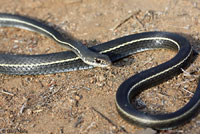 |
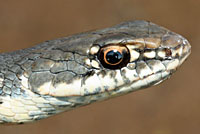 |
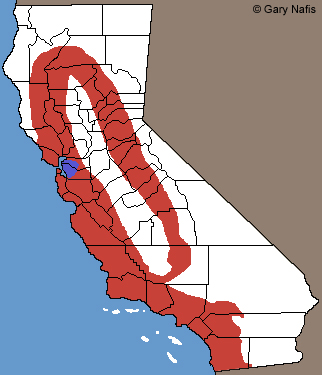 Range shown in Red |
|||||
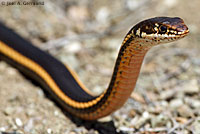 |
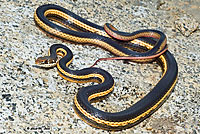 |
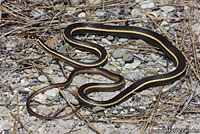 |
|||||||
| © Joel A. Germond | © Chad M. Lane | © Zach Lim | |||||||
| Adults are typically 3 to 4 feet long. A slender very fast-moving snake with large head and eyes and smooth scales. Dark brown or grey with one pale stripe on each side. No stripe on the back. |
Diurnal and conspicuous. Common. Found in a variety of open areas including canyons, rocky hillsides, chaparral, open woodlands, pond edges and stream courses from sea level to the mountains. |
Eats small mammals, lizards, frogs, and snakes Females lay eggs in late spring and early summer. Eggs hatch in late summer and fall. |
|||||||
| Red Coachwhip (or Red Racer) Masticophis flagellum piceus (formerly Coluber flagellum piceus) |
|||||||||
| Not Dangerous to Humans | |||||||||
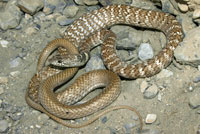 |
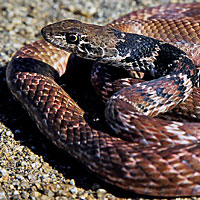 |
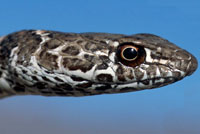 |
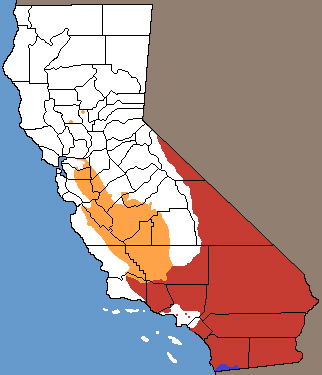 Range shown in Red |
||||||
| Adults are 3 to 8 feet in length. A long slender, fast-moving snake with a large head and eyes and large rough scales. Variable in appearance: brown, tan, or reddish, with black on the head, the neck, and the front part of the body, and light color giving it a banded pattern. |
Diurnal. Common and conspicuous. Found in open areas of grassland, chaparral, scrubland where vegetation is not dense. |
Eats small mammals, birds, lizards, snakes, and amphibians. Females lay eggs in early summer. Eggs hatch in late summer and fall. |
|||||||
| Western Yellow-bellied Racer Coluber constrictor mormon |
|||||||||
| Not Dangerous to Humans | |||||||||
Videos |
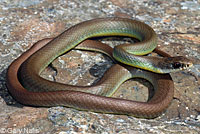 |
 |
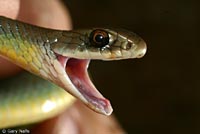 |
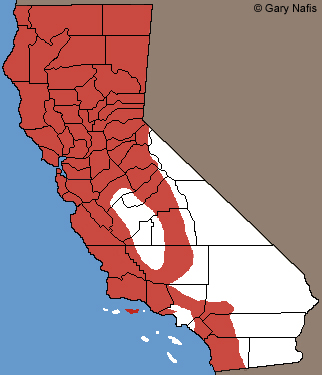 Range shown in Red |
|||||
| Adults have no pattern | Juveniles have a brown blotched pattern | ||||||||
| Adults are typically 2 to 3 feet long. Hatchlings are 8 to 11 inches long. A long slender fast-moving snake with a large head and eyes and a long thin tail. Brown, greenish, or grey without markings. Young are brown with dark brown markings. |
Diurnal. Not very common in our area. Common elsewhere where it occurs. Found in open sunny areas including meadows, grassland, chaparral, open woodlands, and riparian areas, in arid and moist areas. Not found at very high elevations. |
Eats lizards, small mammals, birds, snakes, eggs, frogs, and insects. Females lay eggs in early summer. Young hatch in late summer and fall. |
|||||||
| Coast Patch-nosed Snake Salvadora hexalepis virgultea |
|||||||||
| Not Dangerous to Humans | |||||||||
Video |
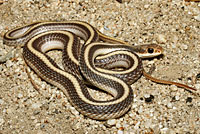 |
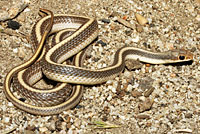 |
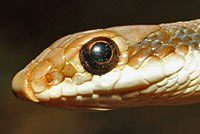 |
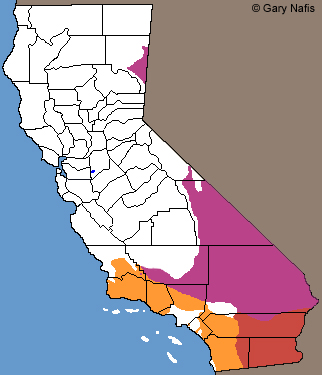 Range shown in Orange |
|||||
| Adults are typically 2 - 3 feet long. A slender, fast-moving snake with large eyes and smooth scales. Gray or brown with a broad pale stripe down the middle of the back and a pale underside. No stripes on the sides. |
Diurnal. Conspicuous, but uncommon. Found in semi-arid brushy areas and chaparral. |
Eats mostly lizards plus small mammals, birds and amphibians. Lays eggs probably May to August which hatch in late summer and fall. |
|||||||
| California Glossy Snake Arizona elegans occidentalis |
|||||||||
| Not Dangerous to Humans | |||||||||
Video |
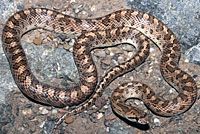 |
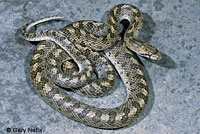 |
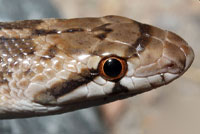 |
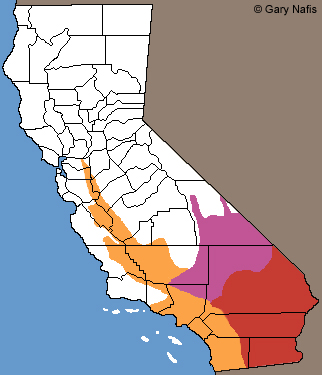 Range shown in Orange |
|||||
| Adults are typically 3 to 4 feet long.
A thick slow-moving snake with smooth glossy scales. Tan or light brown with dark blotches and a pale underside. |
Nocturnal. Uncommon in our area. Found in open areas including arid scrub, grasslands, chaparral, and rocky washes. |
Eats mostly lizards, plus small snakes, birds, and mammals.
Females lay eggs in June and July which hatch in late summer, early fall.
|
|||||||
| San Diego Nightsnake Hypsiglena ochrorhyncha (torquata) klauberi (formerly Hypsiglena torquata nuchalata) |
|||||||||
| Not Dangerous to Humans | |||||||||
Video of similar subspecies |
 |
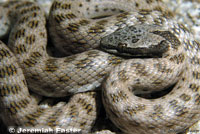 |
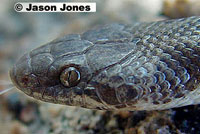 |
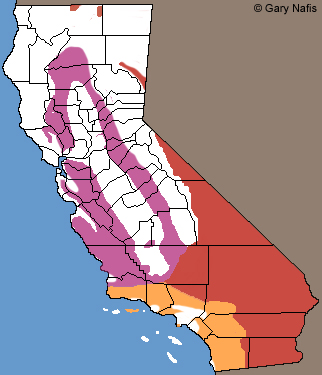 Range shown in Orange |
|||||
| Most adults are about a foot long, rarely over 16 inches. Hatchlings are about 7 inches long. A small slender snake with a narrow head and smooth scales. Light gray, light brown, beige, tan, or cream in color with dark brown or gray blotches on the backs and sides and a dark band on the neck and another through the eyes. |
Nocturnal. Secretive and not often seen. Found in a variety of habitats, including chaparral, suburban lots and gardens, meadows and grassland, from sea level into the mountains. |
Eats mostly lizards and their eggs, plus small snakes, amphibians, and other small vertebrates. Females lay eggs from April to September. |
|||||||
| Coast Mountain Kingsnake Lampropeltis multifasciata |
|||||||||
| Not Dangerous to Humans | |||||||||
Video |
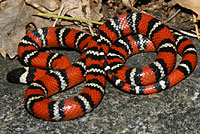 |
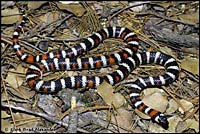 |
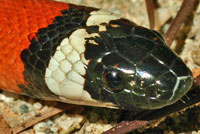 |
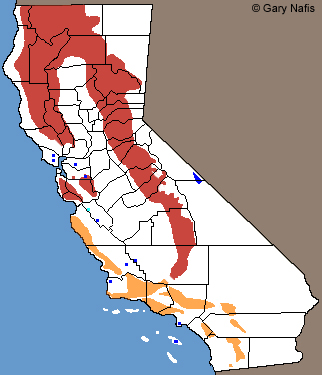 Range shown in Orange |
|||||
| Adults are typically 24 to 30 inches long. Hatchlings are 7 to 11 inches long. A slender snake with a rounded body and almost no neck. Black, red, and white or yellowish bands circle the body. Often some of the black bands cross over the top of the red bands. |
Diurnal. Nocturnal during hot weather. Secretive and not commonly seen. Found in coniferous forest, mixed woodlands, chaparral, manzanita, coastal sage scrub, typically around rock outcrops near streams in the mountains. |
Eats lizards, small mammals, birds, amphibians, and sometimes snakes.
Females lay eggs June and July which hatch August and September.
|
|||||||
|
|||||||||
| Baja California Coachwhip Masticophis fuliginosus (formerly Masticophis fuliginosus) |
|||||||||
| Not Dangerous to Humans | |||||||||
 |
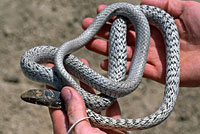 |
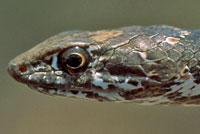 |
 Range shown in Blue |
||||||
| Adults are typically 2 to 4 feet long. A slender fast-moving snake with smooth scales, a large head and eyes. Coloring is dark brown or black. South of our area there is also a silver or grey phase. |
Diurnal. Uncommon due to its limited range. Found in open areas of grassland and coastal sage scrub. |
Eats small mammals, birds, eggs, lizards, snakes, and amphibians.
Females lay eggs in early summer which hatch in early fall. |
|||||||
| Rosy Boa Lichanura orcutti (formerly Lichanura trivirgata roseofusca) |
|||||||||
| Not Dangerous to Humans | |||||||||
|
Videos |
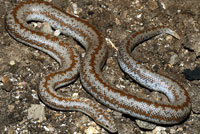 |
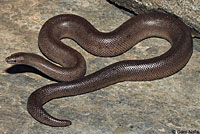 |
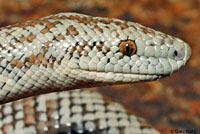 |
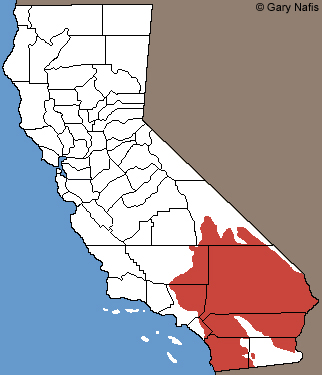 Range shown in Red |
|||||
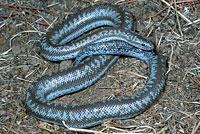 |
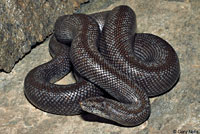 |
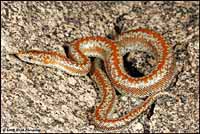 |
|||||||
| © Brad Alexander | |||||||||
| Adults are typically 2 to 3 feet long. Hatchlings are 10 - 14 inches long. A slow-moving heavy-bodied snake with small shiny scales and a blunt tail. The head is barely wider than the neck. Color is grayish or brownish with irregular dark brown, reddish, or orange lengthwise stripes. Some snakes in southern San Diego County lack the stripes and are a nearly solid rusty or purplish color. |
Mostly nocturnal and crepuscular. Common, but secretive. Found in arid and semi-arid scrublands, rocky shrublands, and other rocky areas, especially where near water. |
Eats small rodents, birds, lizards, snakes, and amphibians. Young are born live from October to November. |
|||||||
| Southern Rubber Boa Charina umbratica |
|||||||||
| Not Dangerous to Humans | |||||||||
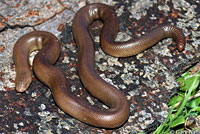 |
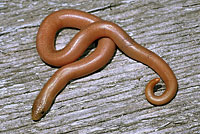 |
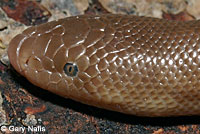 |
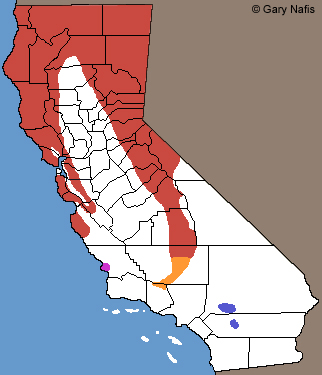 Range shown in Blue |
||||||
| Adults are typically 11 to 15 inches long. A small stout slow-moving snake with small smooth scales, wrinkled skin, and a short blunt tail. Color is light or dark brown, tan, olive, or pinkish. Young can be bright pink. |
Nocturnal and crepuscular. Common but secretive. Found in mixed coniferous forest in areas with rocks and other debris, typically between 5,000 - 8,200 ft. |
Eats small mammals, birds, and lizards. Young are born live in late summer and early fall. Present only in a few areas in the San Bernardino, San Jacinto, and Tehachapi mountains. |
|||||||
| California Red-sided Gartersnake Thamnophis sirtalis infernalis |
|||||||||
| Not Dangerous to Humans | |||||||||
Video |
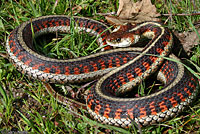 |
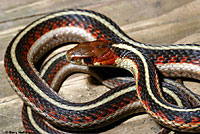 |
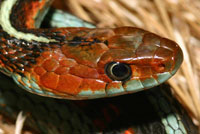 |
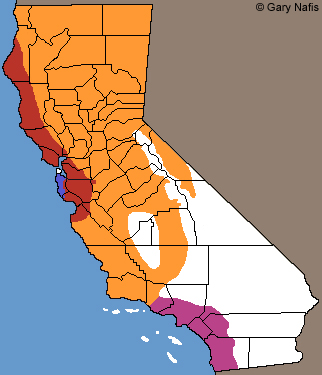 Range shown in Red and Purple |
|||||
| Adults are 15 to 55 inches long, averaging 36 inches. A slender snake with a slight neck, large eyes, and large keeled scales. Color is dark olive to black, with light stripes on the back and on each side. The head is red and there are red markings on the sides between the stripes. |
Diurnal. Rare in our area, but very common elsewhere. Found in a variety of habitats, including grasslands, chaparral, farmland, forests, and mixed woodlands. In our area this snake appears to be restricted to marsh and upland habitats near permanent water with riparian vegetation. |
Eats amphibians, tadpoles, fish, birds, eggs, small mammals, reptiles, earthworms, slugs, and leeches. Able to eat poisonous newts. Young are born live from spring to fall. |
|||||||
| Two-striped Gartersnake Thamnophis hammondii |
|||||||||
| Not Dangerous to Humans | |||||||||
Video |
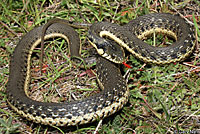 |
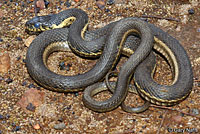 |
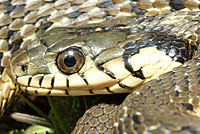 |
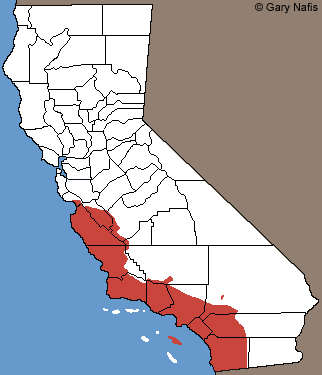 Range shown in Red |
|||||
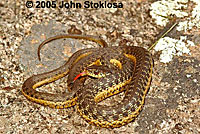 |
 |
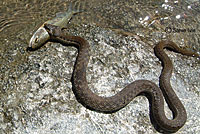 |
|||||||
| © John Stoklosa | © Jeremy Huff | Sometimes found in water hunting for fish © Steve Ivie | |||||||
| Adults are typically 18 - 30 inches long. Newborns are about 8 inches. A slender snake without much of a neck, and keeled scales. Color is drab olive, brown, or gray with a pale stripe on the bottom of each side. There is no stripe on the back. Some snakes have a faint side stripe and two rows of dark spots on each side. |
Mostly diurnal. Active on some hot nights. Fairly Common, but declining due to loss of habitat. Found mostly around water, including ponds, creeks, and cattle tanks, typically in rocky areas in oak woodland, chaparral, brushland, and coniferous forest. From sea level up to about 7,000 ft. in the mountains. |
Eats fish, frogs, toads, tadpoles, newt larvae, and occasionally worms and fish eggs. Young are born live in late July and August. |
|||||||
| Mountain Gartersnake Thamnophis elegans elegans |
|||||||||
| Not Dangerous to Humans | |||||||||
Video |
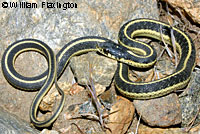 |
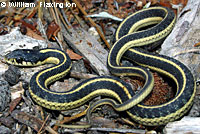 |
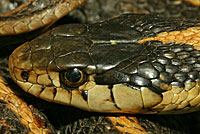 |
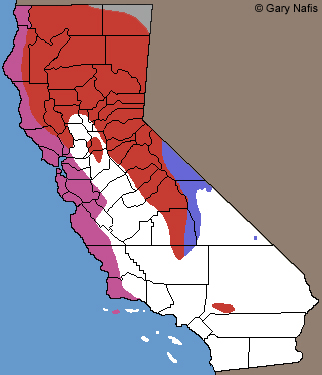 Range shown in Red and Gray |
|||||
| © William Flaxington | © William Flaxington | ||||||||
| Adults are 18 - 43 inches long. A slender snake with a faint neck and keeled scales. Color is dark olive or black with no red markings. There is a pale stripe on each side and one on the back. |
Diurnal. Rare in our area. Found mostly around streams and lakes in grassland, woodland, and coniferous forest. In our area, found only in the San Bernardino Mountains. |
Eats fish, amphibians, birds, mice, lizards, snakes, worms, leeches, slugs and snails. Young are born live from July to September. |
|||||||
| San Bernardino Ring-necked Snake Diadophis punctatus modestus |
|||||||||
| Not Dangerous to Humans | |||||||||
Videos |
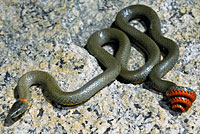 |
 |
 |
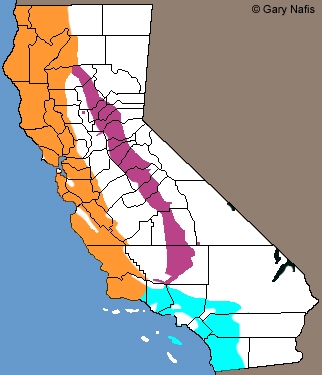 Range shown in Light Blue |
|||||
| Adults grow up to 34 inches long. A small thin snake with smooth scales. Color is gray, dark olive, or black with a narrow orange band around the neck. The underside is bright yellow or orange or speckled with black markings. This underside is often displayed in a coil when a snake is feeling threatened. |
Diurnal and nocturnal. Common but secretive and rarely seen crawling. Found in moist habitats including wet meadows, rocky hillsides, gardens, farmlands, grassland, chaparral, mixed coniferous forest and woodlands. |
Eats small salamanders, tadpoles, frogs, snakes, lizards, worms, slugs, and insects. Females lay eggs in the summer which hatch mostly in the fall. |
|||||||
| Long-nosed Snake Rhinocheilus lecontei |
|||||||||
| Not Dangerous to Humans | |||||||||
Videos |
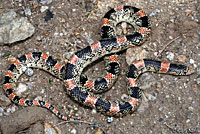 |
 |
 |
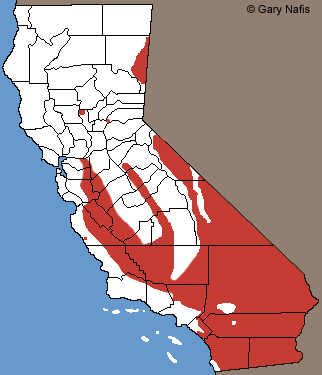 Range shown in Red |
|||||
| Adults are typically 16 to 30 inches long. Hatchlings are 7 to 11 inches long. A slender snake with smooth scales, only a faint neck and a head with a long pointed snout. Color is white with red and black saddles that do not entirely circle the body. Some snakes lack red coloring. |
Nocturnal and crepuscular but occasionally seen active in daylight. Uncommon in our area. More common in the deserts. Found in semi-arid grasslands, shrublands, and prairies. |
Eats mostly lizards and their eggs plus small snakes, small mammals, birds, and insects. Females lay eggs from June to August. |
|||||||
| California Black-headed Snake Tantilla planiceps |
|||||||||
| Not Dangerous to Humans | |||||||||
Videos |
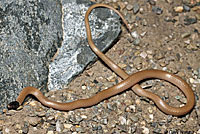 |
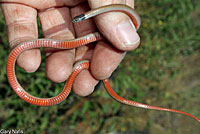 |
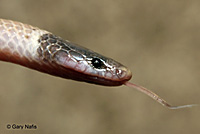 |
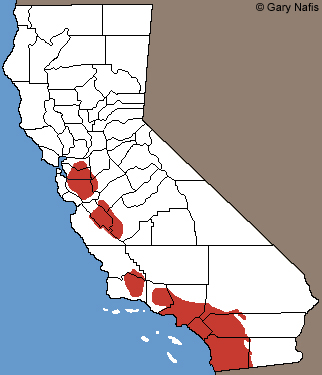 Range shown in Red |
|||||
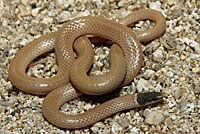 |
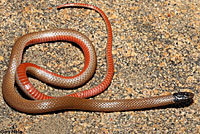 |
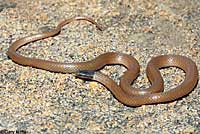 |
|||||||
| From 4 - 15 inches long. A very small, thin snake with a flat head and smooth scales. Color is brown or tan with no markings except for a dark brown or black head with a faint light collar between the body color and the dark head cap. The underside is reddish. |
Nocturnal. Uncommon and secretive. Rarely seen. Found in grassland, chaparral, and mixed woodlands. |
Eats millipedes, centipedes, and insects. Females lay eggs probably in spring, which hatch in summer. |
|||||||
| Southwestern Threadsnake (or Blind Snake) Rena humilis humilis (formerly Leptotyphlops humilis humilis) |
|||||||||
| Not Dangerous to Humans | |||||||||
Video |
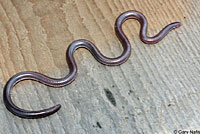 |
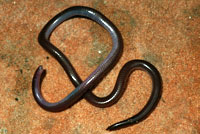 |
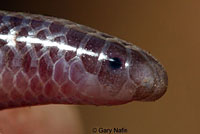 |
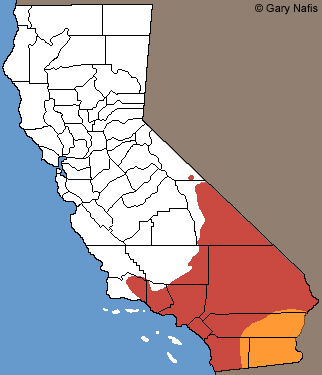 Range shown in Red |
|||||
| Adults are 7 to 16 inches long. Young are 4 to 5 inches long. A very thin small snake with a blunt head and blunt tail and nonfunctional eyes that are just dark spots. Resembles a large worm. Coloring is brown, purple, or pink. |
Nocturnal. Common but secretive and rarely seen. Found in areas with soil that is suitable for burrowing, including brushy slopes, rocky hillsides, washes, and beach sand. |
Eats ants and termites and their larvae and pupae. Females lay eggs in Summer. |
|||||||
| California Lyresnake Trimorphodon lyrophanes |
|||||||||
| Mildly Venomous But Not Dangerous to Humans | |||||||||
Videos |
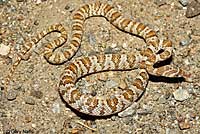 |
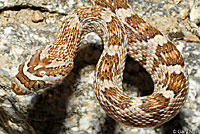 |
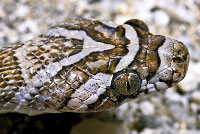 |
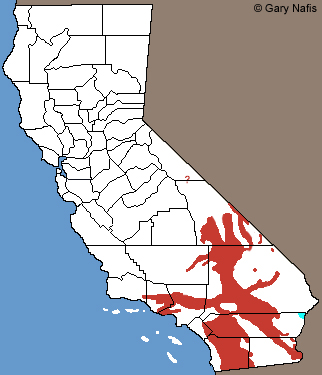 Range shown in Red |
|||||
| Adults are typically 2 to 3 feet long. A slender snake with a large broad head and a slim neck, and large eyes. Color is typically gray or light brown, with dark blotches that have a light crossbar in their middle. |
Nocturnal. Typically found in rocky locations in scrub, grassland, chaparral, oak woodland. |
Eats mostly lizards, plus small mammals, nestling birds, and snakes. |
|||||||
| Southern Pacific Rattlesnake Crotalus oreganus helleri (formerly Crotalus viridis helleri) |
|||||||||
| Venomous and Potentially Very Dangerous | |||||||||
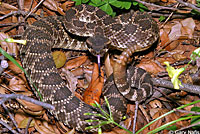 |
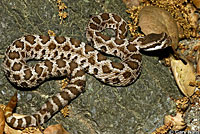 |
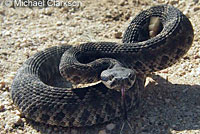 |
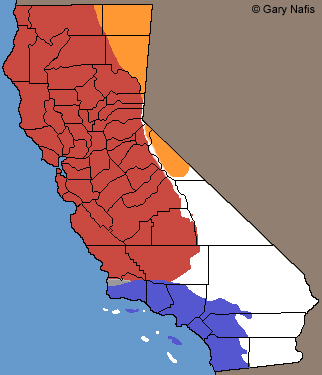 Range shown in Blue
|
||||||
Videos |
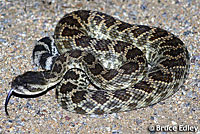 |
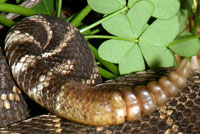 |
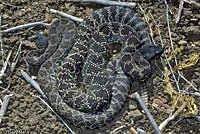 |
||||||
| Adults are typically 3 to 4 feet long. A heavy-bodied snake with a large triangular head and thin neck, and large keeled scales, and a tail tipped with a rattle that is shaken to produce a loud sound when the snake is feeling threatened. Young snakes have no rattle and cannot make a sound. Color is brown, olive, or black, with dark brown blotches outlined by light pigment on the back, and dark bars on the tail. |
Nocturnal and crepuscular in hot temperatures, and also diurnal during moderate temperatures. Common and conspicuous. Found in many habitats, including seaside dunes, scrub, grasslands, rocky hillsides, chaparral, open woodlands, and agricultural fields. |
Eats small mammals, birds, lizards, snakes, and frogs. Young are born live from August to October. |
|||||||
| Red Diamond Rattlesnake Crotalus ruber |
|||||||||
| Venomous and Potentially Very Dangerous | |||||||||
Videos |
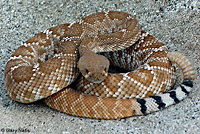 |
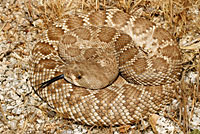 |
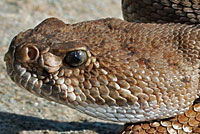 |
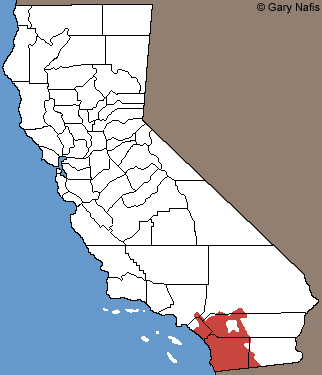 Range shown in Red |
|||||
| Adults are typically 2 to 4.5 feet long. Young are about 12 inches long. A heavy-bodied snake with a large triangular head and thin neck, and large keeled scales, and a tail tipped with a rattle that is shaken to produce a loud sound when the snake is feeling threatened. Young snakes have no rattle and cannot make a sound. Color is brown, tan or reddish, with dark diamond-shaped blotches on the back. The tail is circled with black and white rings. |
Nocturnal and crepuscular, but diurnal in shaded areas and when the temperature is moderate. Common and conspicuous. Found in arid scrub, chaparral, oak and pine woodlands, rocky grassland, and cultivated areas. |
Eats small mammals, lizards, and birds. Young are born live from July to September. |
|||||||
| Southwestern Speckled Rattlesnake Crotalus pyrrhus |
|||||||||
| Venomous and Potentially Very Dangerous | |||||||||
Videos |
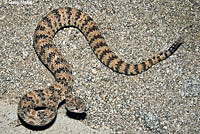 |
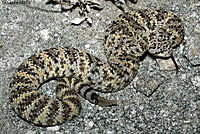 |
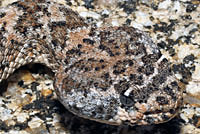 |
 Range shown in Red |
|||||
| Adults are typically 2 - 4 feet long. Young are 9 or 10 inches long. A heavy-bodied snake with a large triangular head and thin neck, and large keeled scales, and a tail tipped with a rattle that is shaken to produce a loud sound when the snake is feeling threatened. Young snakes have no rattle and cannot make a sound. Color varies widely to match the environment, from off-white, yellow, gray, tan, pink, orangish, to brown. A vague pattern of dark speckled banded markings cover the body. The tail is circled with dark and light rings. |
Nocturnal and crepuscular during hot periods and diurnal during moderate temperatures. |
Eats small mammals, lizards, and birds. Young are born live in July and August. |
|||||||
| Yellow-bellied Sea Snake Hydrophis platurus |
|||||||||
| Venomous and Potentially Very Dangerous | |||||||||
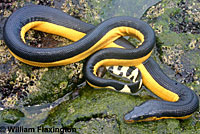 |
 |
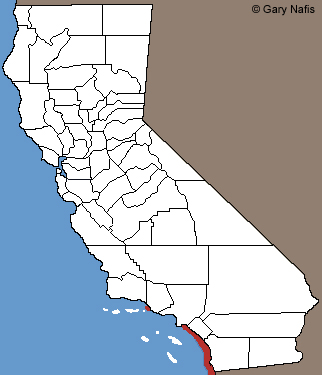 Range shown in Red |
|||||||
| Adults are typically 18 - 25 inches long. An aquatic snake with a flattened body and tail that spends most of its life in the ocean. Color is dark brown or black with a bright yellow or pale yellow underside which extends up onto the sides. |
Diurnal. Rare in our area. Usually seen within a few miles of the shore in drift lines. |
Eats small fish and eels. Young are born live in the ocean. |
|||||||
Established Snakes Not Native to California |
|||||||||
| Southern Watersnake Nerodia fasciata Not Native to California |
|||||||||
It is unlawful to import, transport, or possess any Watersnakes of the genus Nerodia in |
|||||||||
| Not Dangerous to Humans | |||||||||
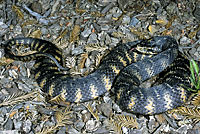 |
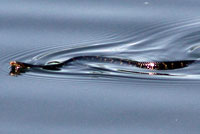 |
 |
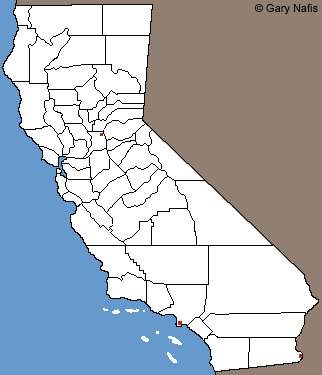 Range shown in Red dots |
||||||
| Adults are typically 22 to 40 inches long. A heavy-bodied snake with large keeled scales. Color is yellowish to reddish-gray with many dark cross-bands. Juveniles are paler with a stronger pattern. Very old snakes may be almost entirely dark. |
Diurnal and Nocturnal. Uncommon. Found in and around permanent bodies of water, especially those bordered by woods. |
Eats fish, frogs, salamanders, and crayfish. Young are born live. Not a native snake. So far, known to be established only in Harbor City. |
|||||||
| Brahminy Blindsnake Indotyphlops braminus Not Native to California Please email me if you see this species in the wild in California, and send pictures if you can. |
|||||||||
| Not Dangerous to Humans | |||||||||
Video |
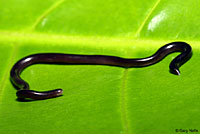 |
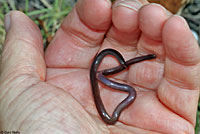 |
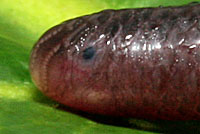 |
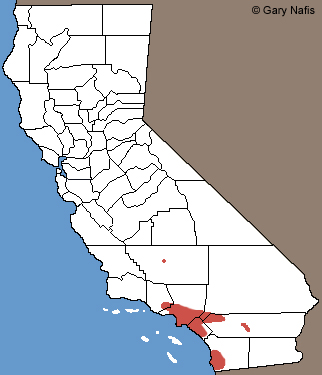 Current likely range shown in Red. |
|||||
| Adults are typically 2.5 to 7 inches long. Very similar to the native Southwestern Threadsnake but typically darker in color. A very thin small snake with a blunt head and blunt tail and nonfunctional eyes that are just dark spots. Resembles a large worm. |
Nocturnal. Common but secretive and rarely seen. Usually seen hiding under surface objects such as rocks and boards. Found in areas with soil that is suitable for burrowing, including brushy slopes, rocky hillsides, washes, and beach sand. Has spread around the world, most likely through snakes or eggs that are hiding or deposited in the pots and soil of imported commercial plants. |
Lays eggs, but all snakes are females and do not need to find a male in order to breed. Not a native snake. Documented in Chula Vista with other southern California locations probable. |
|||||||
| Lizards | |||||||||
Most lizards in coastal Southern California are active during warm and sunny weather, typically from late February through October, and remain underground at other times.They become active later at higher elevations, and go underground sooner. They are most often seen during daylight sunning themselves on rocks, branches, fences, or walls, or running on the ground. |
|||||||||
| Great Basin Fence Lizard Sceloporus occidentalis longipes |
|||||||||
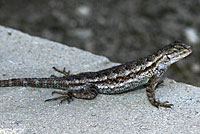 |
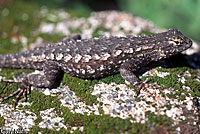 |
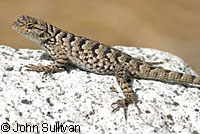 |
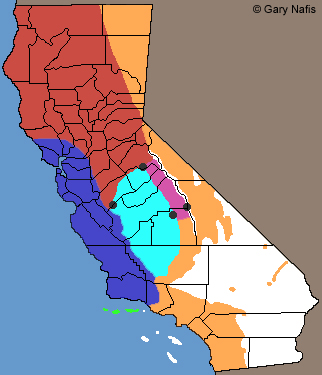 Range shown in Orange |
||||||
Video |
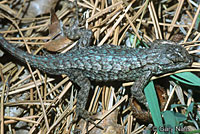 |
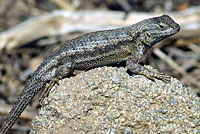 |
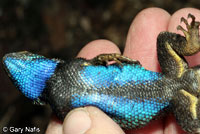 |
||||||
| Adults are about 2.5 to 3.5 inches long, not including the tail. A fairly small lizard with keeled scales. Brown, gray, or black with dark blotches on the back. Sometimes light markings on the sides of the back form vague stripes. Recognizing differences between Fence Lizards and Sagebrush Lizards. |
Diurnal. The most common and conspicuous lizard in our area. Found in many different open, sunny areas, including woodlands, grasslands, chaparral, waterways, pond edges, houses and fences. |
Eats small bugs including crickets, spiders, ticks, scorpions, and even tiny lizards. Females lay eggs that hatch July to September, when very tiny lizards can be seen running around. Typically seen basking in the sun on rocks, fences, walls, and fallen branches. |
|||||||
| Southern Alligator Lizard Elgaria multicarinata |
|||||||||
Video |
 |
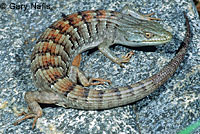 |
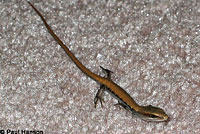 |
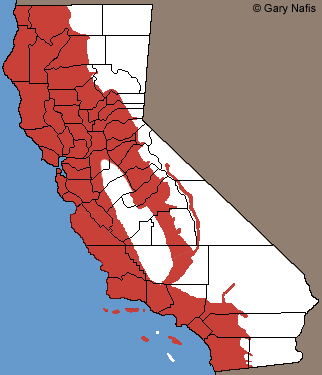 Range shown in Red |
|||||
| Adults are about 3 to 7 inches long, not including the tail, and can be up to 16 inches long including the tail. An elongated lizard with large scales, a large head, short legs, and a fold along the bottoms of the sides. The tail can be very long, but often it is re-grown and stubby. Brown, grey, or yellowish above, often with orange or red coloring on the middle of the back. Usually there are dark bands on the back, sides, and tail. Juveniles are long and thin and a copper color with no dark markings on the back. They are sometimes mistaken for a small ground skink (which does not occur in this area.) |
Diurnal. Common. Found in grassland, open forest, chaparral, oak woodlands. Typically prefers drier areas than the San Francisco Alligator lizard. |
Eats a variety of small bugs, slugs, snails, and worms, and sometimes small lizards and mammals and birds and their eggs. Females lay eggs from May to July which hatch in late summer and early fall. Typically seen moving on the ground or basking on rocks or fallen branches. Moves with a snake-like undulating motion. |
|||||||
| Western Side-blotched Lizard Uta stansburiana elegans |
|||||||||
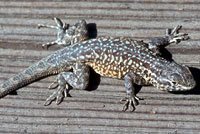 |
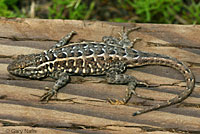 |
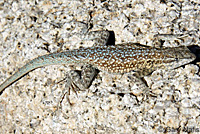 |
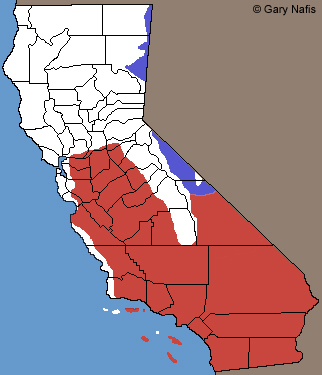 Range shown in Red |
||||||
Video |
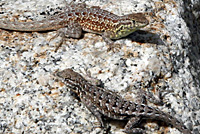 |
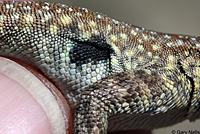 |
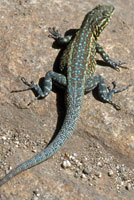 |
||||||
| Adults are 1.5 to 2.5 inches long, not including the tail. A small lizard with smooth scales and a large dark marking, or blotch, on the sides, just behind the front limbs, which is not easily seen at a distance. Brown, black, gray, or yellowish in color with dark blotches, spots, and sometimes stripes, on the back. Sometimes there is a double row of dark wedge-shaped markings on the back, edged with white. Males have blue speckles on the back and can be very colorful. |
Diurnal. Common and conspicuous. Found in open rocky areas with scattered vegetation, including sandy washes, vegetated with chaparral, scattered trees, grass, and shrubs. |
Eats small bugs including beetles, grasshoppers, ants, spiders, scorpions, and ticks. Females lay eggs from March to August which hatch from June to September. Typically seen basking on rocks or fallen branches or running on the ground in-between rocks. |
|||||||
| Southern California Legless Lizard Anniella stebbinsi |
|||||||||
Video |
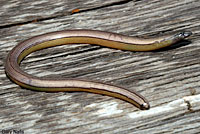 |
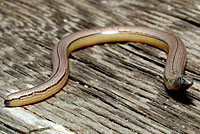 |
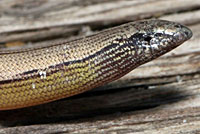 |
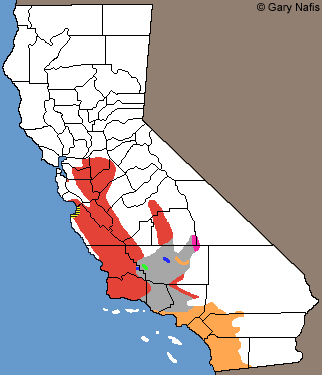 Range shown in Orange |
|||||
| Adults are about 5 to 7 inches long. A small slender lizard a shovel-shaped snout, smooth shiny scales, a blunt tail, and no legs. Often thought to be a small snake. Color varies from metallic silver, beige, dark brown, to black. Usually there is a dark line along the back and several thin stripes on the sides. |
Diurnal. Often common, but secretive - rarely seen. Found in beach dunes, chaparral, mixed woodlands, sandy washes and stream terraces where there is moist warm loose soil with plant cover. |
Eats mostly insect larvae, beetles, termites, and spiders. Young are born live September to November. Typically found in suburban gardens under leaf litter or loose soil under shrubs. |
|||||||
| Coast Horned Lizard Phrynosoma blainvillii (formerly Blainville's Horned Lizard) |
|||||||||
Video |
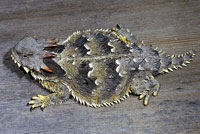 |
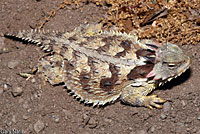 |
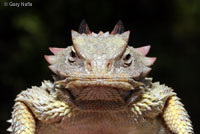 |
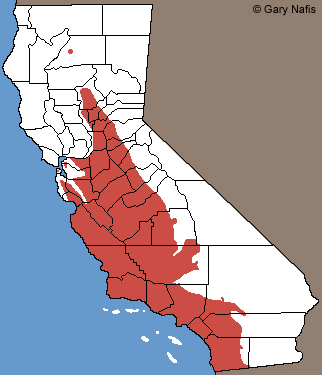 Range shown in Red |
|||||
| Adults are 2.5 to 4.5 inches long, not including the tail. A flat lizard with a very wide oval body, large pointed scales protruding from the body and the short flat tail, and very large pointed horns around the back of the head. Unlike any other lizard in our area. Brown, reddish, or yellowish with dark blotches on the back. |
Diurnal. Common in some areas, but gone from much of its previous range due to loss of habitat and harvester ants. Found in areas with loose sandy soil and low vegetation, including grassland, forests, woodlands, and chaparral. |
Eats mostly large harvester ants plus the occasional spider, beetle, termite, fly, bee, or grasshopper. Females lay eggs from May to June which hatch from August to September. Typically seen in open spaces on the ground or running across a road, often around anthills or ant trails. |
|||||||
| San Diego Banded Gecko Coleonlyx variegatus abbotti |
|||||||||
Videos |
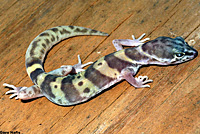 |
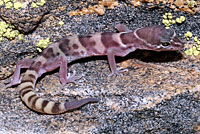 |
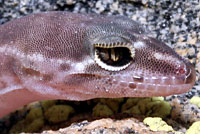 |
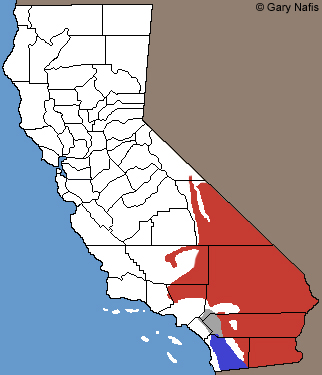 Range shown in Blue |
|||||
| 2 to 3 inches long. A small lizard with eyelids and vertical pupils, and smooth skin. Pale yellow, pink, or light gray with tan or brown bands on the body and tail. |
Diurnal. Uncommon. Found in rocky areas in coastal sage and chaparral. |
Eats a variety of small invertebrates. Females lay eggs from May to September which hatch in 45 days. Typically found underneath rocks or other surface debris. |
|||||||
| Granite Night Lizard Xantusia henshawi |
|||||||||
Videos |
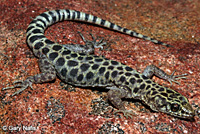 |
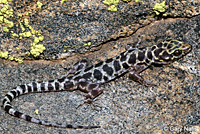 |
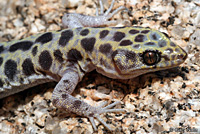 |
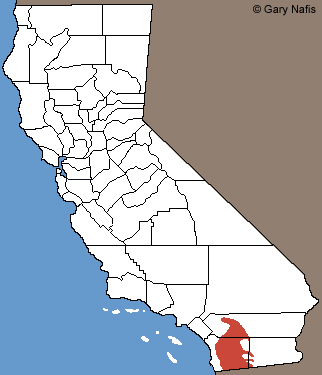 Range shown in Red |
|||||
| 2 to 2.75 inches long not including the tail. A small lizard with a flattened body and head, smooth skin, lidless eyes with vertical pupils, a long thin tail. Seen in a light phase - white or yellowsh with large dark brown spots on the upper body, and a dark phase - dark brown with a pale white or yellow network on the upper body. |
Nocturnal, but may be active diurnally in shade. Found in rocky canyons and hillsides in semiarid regions, typically with massive boulders and rock outcrops with exfoliated granite in the shadier parts of canyons. |
Eats small invertebrates, including spiders, scorpions, beetles, ants, and centipedes. Young are born live in the fall. Typically seen underneath rocks, in cracks in rock outcrops, or on the surface of rocks at night. Sometimes seen on walls at night in areas near large rock outcrops. |
|||||||
| Southern Sagebrush Lizard Sceloporus vandenburgianus |
|||||||||
Video |
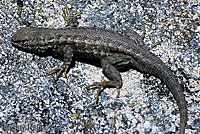 |
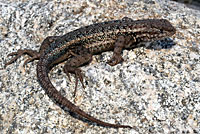 |
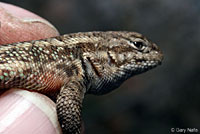 |
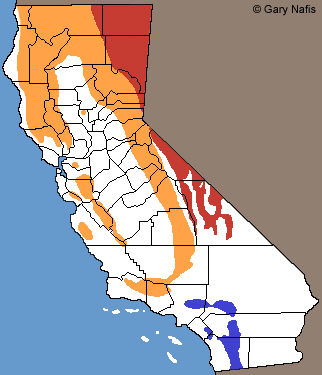 Range shown in Blue |
|||||
| Adults are about 2 to 3.5 inches long not including the tail. A small lizard with small keeled scales. Gray or brown in color with dark blotches or irregular bands on the body and tail and light stripes along the sides and upper sides at the edge of the back. There is usually a bar of black on the shoulder and rusty coloring on the armpits Males show blue coloring on the throat and sides of the belly. Females develop orange coloring on the throat and sides when they are gravid. |
Diurnal. Common and conspicuous where found. Found in the transverse and peninsular mountains in shrublands such as chaparral, manzanita and ceanothus, and in open pine and Douglas Fir forests where there are open areas that get a lot of sun. In our area, found at higher elevations, typically 4,500 ft. and higher. |
Eats small bugs including ants, termites, grasshoppers, flies, spiders, and beetles. Females lay eggs from June to August that hatch in August and September. Typically seen basking on rocks or fallen branches or running on the ground inbetween rocks. Recognizing differences between Fence Lizards and Sagebrush Lizards. |
|||||||
| Coastal Whiptail (San Diegan Tiger Whiptail) Aspidoscelis tigris stejnegeri |
|||||||||
Video |
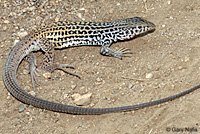 |
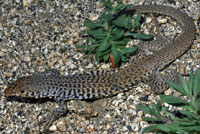 |
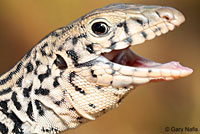 |
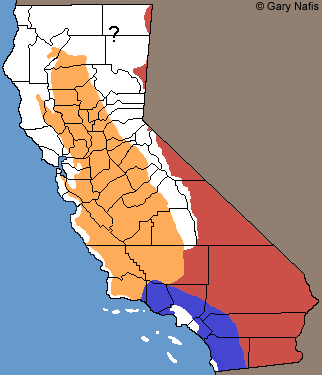 Range shown in Blue |
|||||
| Adults are about 3 to 5 inches long, not including the tail. A long slim lizard with a long thin tail, a thin snout, and large plates on the head. The back and sides are grey, tan, or brown, marked with dark spots or bars or mottling, which is often very sharply defined. Dark marks on the side don't form vertical bars. Usually 8 poorly-defined light brown stripes are present, but stripes on the side are less well-defined. The throat is pale with with large black spots. Juveniles have distinct stripes and bright blue tails. |
Diurnal. Common and conspicuous, but not found in most of our area. Found in hot, dry, open areas with sparse vegetation, including woodland, chaparral, and riparian areas. |
Eats small bugs including spiders, scorpions, centipedes, and termites. Also known to eat small lizards. Females lay eggs from April to August. Very active, moving quickly on the ground with abrupt starts and stops. |
|||||||
| Belding's Orange-throated Whiptail Aspidoscelis hyperythra beldingi |
|||||||||
Video |
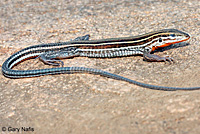 |
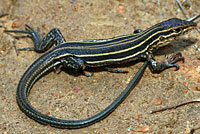 |
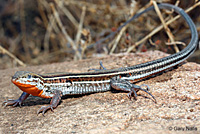 |
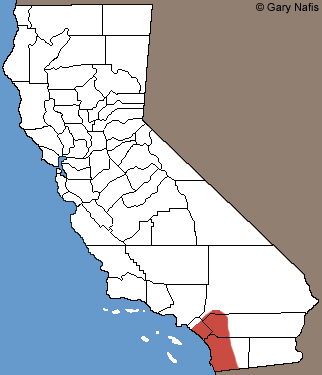 Range shown in Red |
|||||
| 2 to 2.75 inches long, not including the tail. A small fast-moving slim-bodied lizard with a long slender tail, a thin snout, and large plates on the head. Dark brown, black, or gray with 6 or less light stripes on the back and sides. The throat is orange, becoming brighter during the breeding season. |
Diurnal. Found in semi-arid brushy areas with loose soil and rocks. |
Eats small invertebrates including spiders, scorpions, centipedes, and termites, and sometimes small lizards. Females lay eggs in June and July which hatch in August and September. Very active, moving quickly on the ground with abrupt starts and stops. |
|||||||
| Granite Spiny Lizard Sceloporus orcutti |
|||||||||
|
Videos |
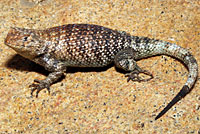 |
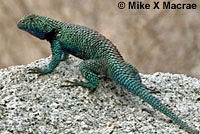 |
 |
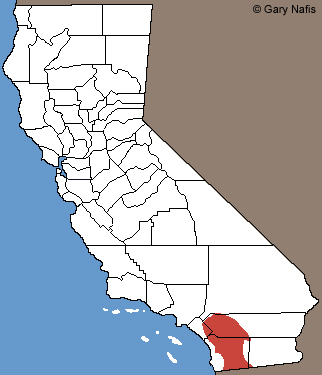 Range shown in Red |
|||||
| Adults are about 3 to 5 inches long, not including the tail, and up to 11 inches with the tail. A large, dark lizard with large pointed scales, a dark wedge of color on the sides of the neck, and dark bands across the body. Dark rusty coppery brown to black in color. Sometimes lizards appear to be solid black before they have warmed up. Males, when warmed up in the sun, have a vivid blue-green sheen with a wide purple stripe on the back and yellow on the sides. |
Diurnal. Common. Found in areas with large boulders and granite outcrops or cliffs with mixed vegetation, including chaparral, mesquite, pine and oak, and palms. From near sea level to about 7,000 ft. |
Eats small invertebrates, small lizards, and occasionally fruits and flowers. Females lay eggs from May to July, which hatch from July to October. Typically seen crawling on large rocks. Very wary and quick to run back into cracks in the rocks when approached. |
|||||||
| Western Red-tailed Skink Plestiodon gilberti rubricaudatus (formerly Eumeces gilberti rubricaudatus) |
|||||||||
Video |
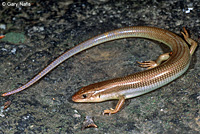 |
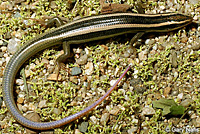 |
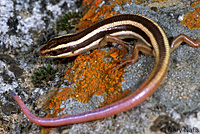 |
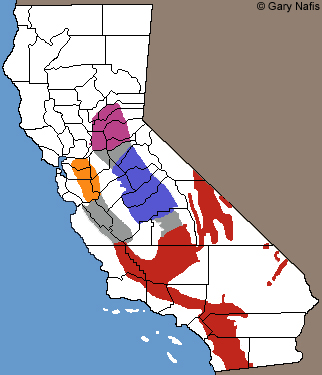 Range shown in Red and Gray |
|||||
| Adults are 2.5 to 4.5 inches long, not including the tail, and up to about 13 inches long including the tail. A large lizard with a heavy body, small head and thick neck, small legs, and smooth shiny scales. Olive or brown in color with some dark markings on the back that begin as dark stripes and fade with age. Young skinks have distinct light and dark stripes and a reddish or pink tail. Males develop red coloring on the throat during the breeding season. |
Diurnal. Secretive and not commonly seen moving around. Found in grassland, chaparral, woodlands, and pine forests, typically where there is moisture nearby. |
Eats small bugs. Females lay eggs in the summer. |
|||||||
| Northwestern (Skilton's) Skink Plestiodon skiltonianus skiltonianus (formerly Eumeces skiltonianus skiltonianus) |
|||||||||
Video |
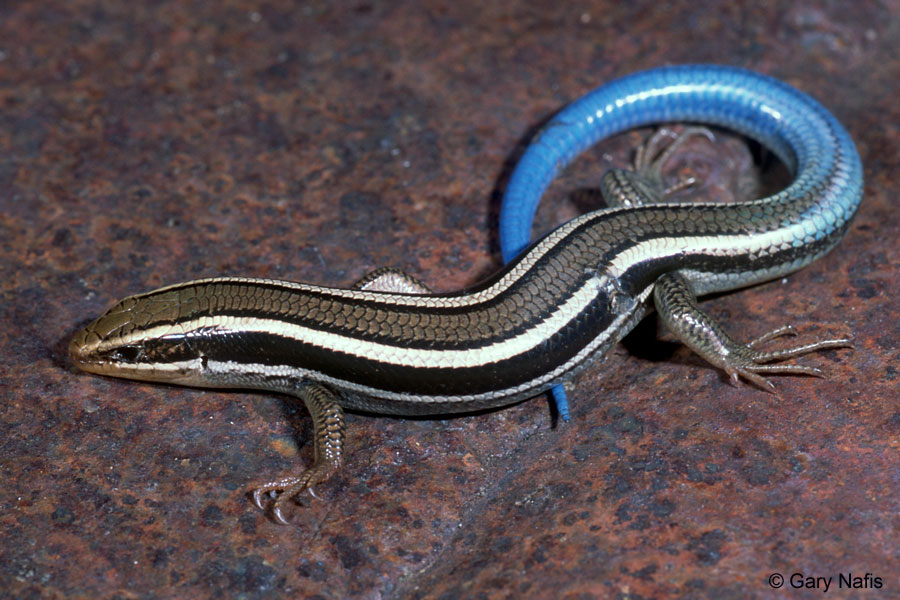 |
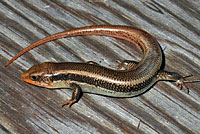 |
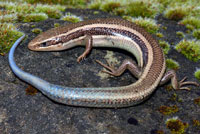 |
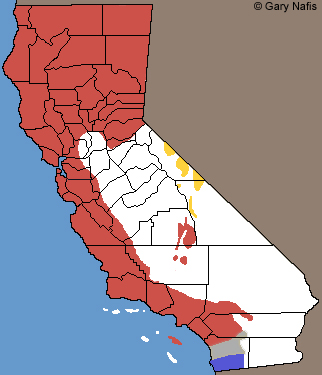 Range shown in Red and Gray |
|||||
| Adults are about 2 - 3 inches long, not including the tail. Typically 7.5 inches long with the tail. A small lizard with a slim body, a small head with a thick neck, small legs, and smooth shiny scales. Dark brown on the head and back with two light stripes on the edge of the back, dark stripes down the sides, and light strips on the edge of the belly. Juveniles have a bright blue tail that fades as they age. Old adults often have no blue on the tail. Adults develop red or orange coloring on the head and throat during the breeding season. |
Diurnal. Common but secretive and not often seen moving around. Found in grassland, woodlands, forests, sagebrush, chaparral, especially in rocky areas near streams and open sunny areas. Sometimes, when this lizard moves quickly through leaf litter or short grass, only the blue tail is seen, and this is often mistaken to be a small blue snake. |
Eats small bugs, including spiders and sow bugs. Females lay eggs in June and July which hatch in July and August. Found in the Northern part of coastal Southern California, mostly north of San Diego County. Typically found underneath rocks, logs, and other surface debris. |
|||||||
| Coronado Skink Plestiodon skiltonianus interparietalis (formerly Eumeces skiltonianus interparietalis) |
|||||||||
of similar subspecies |
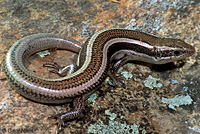 |
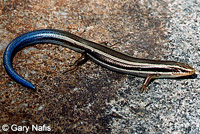 |
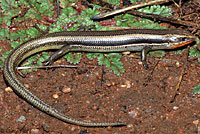 |
 Range shown in Blue and Gray |
|||||
| Adults are about 2 - 3 inches long, not including the tail. Typically 7.5 inches long with the tail. A small lizard with a slim body, a small head with a thick neck, small legs, and smooth shiny scales. Dark brown on the head and back with two light stripes on the edge of the back, dark stripes down the sides, and light strips on the edge of the belly. Juveniles have a bright blue tail that fades as they age. Old adults often have no blue on the tail. Adults develop red or orange coloring on the head and throat during the breeding season. |
Diurnal. Common but secretive and not often seen moving around. Found in grassland, woodlands, forests, sagebrush, chaparral, especially in rocky areas near streams and open sunny areas. Sometimes, when this lizard moves quickly through leaf litter or short grass, only the blue tail is seen, and this is often mistaken to be a small blue snake. |
Eats small bugs, including spiders and sow bugs. Females lay eggs in June and July which hatch in July and August. Found in the Southern part of coastal Southern California, mostly in San Diego County. Typically found underneath rocks, logs, and other surface debris. |
|||||||
Established Lizards Not Native to California |
|||||||||
| Bosc's Fringe-toed Lizard Acanthodactylus boskianus Not Native to California Please email me if you see this species in the wild in California, and send pictures if you can. |
|||||||||
 |
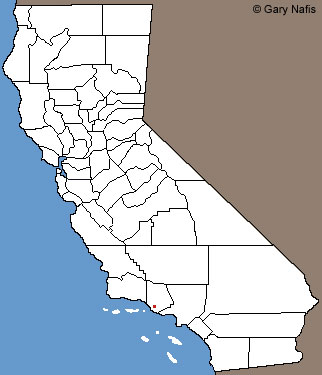 Range in California: Red Range in California: Red |
||||||||
| Dana Biosphere Reserve, Jordan © Charles J. Sharp (This is a smaller version of the original with a copyright added to it. Click on the image to see the original.) |
|||||||||
| A medium-sized slender lizard with a pointed snout. The dorsal surface is an olive gray color with five darker longitudinal stripes. The middle stripe subdivides at the neck. The throat and underside are white and not marked. "Dorsal pattern of adults a mix of faint stripes and alternating black and brown blotches; striping is reduced or absent in older adults. Males have yellowish wash on sides of torso and base of tail and have relatively large head and limbs. Hatchlings are boldly marked, with 7 light stripes on black background; stripes converge near base of tail and fade out by midpoint of tail, which is faint bluish gray on distal half; dorsal surfaces of limbs have vivid light spots on dark background." (Hansen and Shedd 2025) The feet have long thin digits with lateral fringes, which are adaptations that help the lizard move quickly across loose sand. in the breeding season the underside of the tail of a female turns red. |
Diurnal Fast-moving Forages actively, mostly on the ground, but will jump up to low bushes to catch insects. |
Established in a small agricultural--industrial area in coastal Ventura County. | |||||||
| Green Anole Anolis carolinensis Not Native to California Please email me if you see this species in the wild in California, and send pictures if you can. |
|||||||||
Videos |
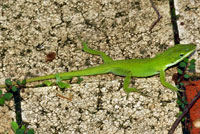 |
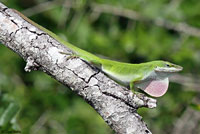 |
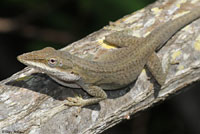 |
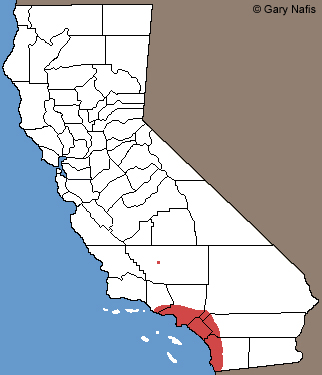 This lizard continues to expand its range in California. Red marks on the map indicate some of the areas where it has been found and could be established. |
|||||
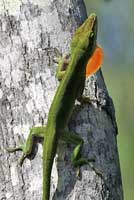 |
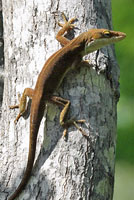 |
 |
|||||||
| A small thin lizard with a long head and snout and a long thin tail. About 3 inches long, not including the tail. 5-8 inches long with the tail. This lizard varies in appearance from bright green to dark or light brown, sometimes with a white stripe down the middle of the back. Males are territorial and often extend a pinkish dewlap from the throat. These lizards can change in seconds from green to brown, as you can see in the two pictures immediately above which are the same lizard. You can see this lizard change colors on the top video above, showing why this anole is often called a Chameleon. |
Diurnal. Native to the south and eastern USA. A species not native to California, typically spread by pets, or animals kept for food for lizard-eating snakes, that have escaped or have been abandoned. Found living in plants often in yards and gardens. Currently recorded from many locations in Southern California, but probably als established in more areas, and spreading. Eats a variety of small invertebrates. |
Comparison with Brown Anole Brown Anoles are less arboreal than Green Anoles, tending to stay closer to the ground. Green Anoles tend to go higher up into trees, although they can also be found lower down. Brown Anoles are always gray, light brown, or dark brown, never green. Green Anoles can turn from dark brown to bright green. Male Brown Anoles have a bright orange-red dewlap with a cream to yellow border. Male Green Anoles have a pink dewlap. (Be aware that dewlaps appear different colors when seen in different lights.) Brown and Green Anoles are about the same size, but Green Anoles have a larger and longer head. |
|||||||
| Brown Anole Anolis sagrei Not Native to California Please email me if you see this species in the wild in California, and send pictures if you can. |
|||||||||
Videos |
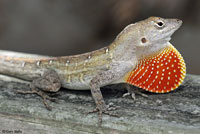 |
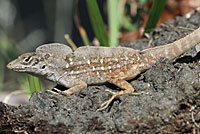 |
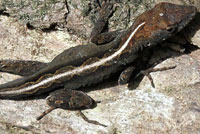 |
|
|||||
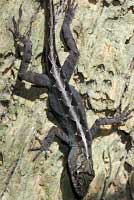 |
 |
 |
|||||||
| A small thin lizard with a long head and snout and a long thin tail. About 2.5 inches long, not including the tail. Up to 8 inches long with the tail. This lizard varies in appearance. Sometimes there is a crooked white stripe down the middle of the back or other dark pattern, but the ground color is always some shade of brown or tan. This lizard is never green. Males are territorial and often extend an orange-red dewlap from the throat. |
Diurnal. Native to Cuba. Not native to California. Known to hitchhike in shipments of exotic plants from Florida. Released or escaped pets are another possible source of their spread. Found living in plants often in yards and gardens. Currently recorded from a few locations in Southern California, but probably established in more areas, and spreading. Eats a variety of small invertebrates. |
Comparison with Green Anole Brown Anoles are less arboreal than Green Anoles, tending to stay closer to the ground. Green Anoles tend to go higher up into trees, although they can also be found lower down. Brown Anoles are always gray, light brown, or dark brown, never green. Green Anoles can turn from dark brown to bright green. Male Brown Anoles have a bright orange-red dewlap with a cream to yellow border. Male Green Anoles have a pink dewlap. (Be aware that dewlaps appear different colors when seen in different lights.) Brown and Green Anoles are about the same size, but Green Anoles have a larger and longer head. |
|||||||
| Sonoran Spotted Whiptail Aspidoscelis sonorae Not Native to California Please email me if you see this species in the wild in California, and send pictures if you can. |
|||||||||
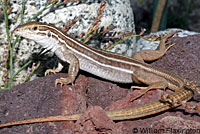 |
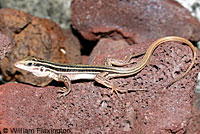 |
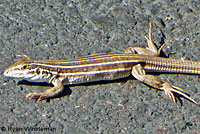 |
 Red dots on the map indicate the area where this species has been found and could be established. |
||||||
| Adult, Orange County © William Flaxington |
Juvenile, Orange County © William Flaxington |
Adult, Orange County © Ryan Winkleman |
|||||||
| A moderately-large slim-bodied lizard with a long slender tail, a pointed snout, large symmetrical head plates, and a long tail tapering to a thin point about twice the size of the body. The average snout to vent length of both species is approximately 3.5 inches (90 mm). The ground color is blackish, brown, or reddish. There are 6 distinct light-colored longitudinal stripes on the back and sides. Light spots are present in the dark fields between the stripes. Spots that are lighter in color than the light stripes may also extend onto the stripes. Older individuals tend to be more heavily spotted. |
Diurnal. A very active forager, often continually moving along the ground, poking its snout into leaf litter and bushes, and sometimes using the feet to dig into and scratch leaf litter when searching for food. Eats a variety of insects (termites, beetles, grasshoppers) arthropods, and spiders Both species are made up of only females that do not need males to fertilize their eggs. They reproduce with unfertilized eggs. The eggs hatch into genetically identical female lizards. In California, found in landscaping and on parking lot asphalt. So far, as of 7/17, they have been found only in Orange County in Irvine, Lake Forest, and Aliso Viejo, but they appear to be spreading quickly. |
Native Populations are found primarily in oak woodlands and grassland, but also ranges into pine/oak woodlands and desert scrub. Seems to prefer riparian corridors. |
|||||||
| Common Checkered Whiptail Aspidoscelis tesselatus Not Native to California Please email me if you see this species in the wild in California, and send pictures if you can. |
|||||||||
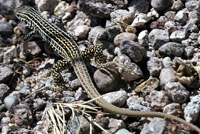 |
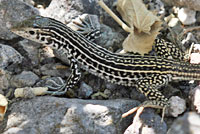 |
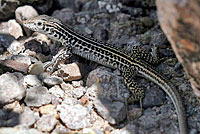 |
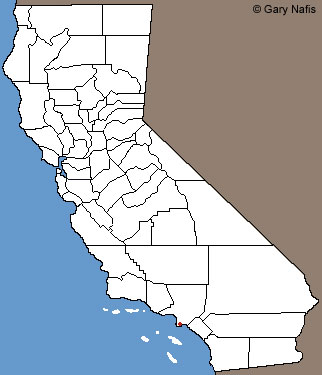 Red dot on the map indicatse the area where this species has been established. |
||||||
| Adult, Presidio County, Texas | |||||||||
| A large whiptail, to about 4.2 inches long from snout to vent (106 mm.) The body is long and tubular, with large plate-like scales on the head, small granular scales on the body, and large square scales on the tail and underside. The head is narrow with a pointed snout, the forelimbs are small, and the hind limbs are long. The tail is very long and thin, sometimes twice the length of the body. The back is marked with 6 to 8 longitudinal stripes with spots and bars that connect to form a checkered appearance. Stripes are more prominent in juveniles. As adults age, their stripes become broken or disappear. |
Diurnal Fast-moving Forages actively, flicking the tongue and twitching the head and body, and digging prey out of soil and leaf litter and using claws to dig prey out of dead plants. Very wary of its environment, but like most whiptails, allows fairly close approach as it forages. Insectivores. Eats grasshoppers, beetles, butterflies, moths in native range, with termites being an important part of the diet. Diet in California is not known. Known predators are birds and snakes, especially Coachwhips. |
Asexual. An all-female (parthenogenetic) species that does not need males for reproduction. Native range is parts of Texas, New Mexico, Colorado, Oklahoma, and Chihuahua and Coahuila, Mexico. Established in Long Beach, Los Angeles County. In its native range, found in grasslands, plains, desert scrublands, and open woodlands. Often associated with rocky or gravel soils, but also found in sandy areas. California populations are found in urban environments. |
|||||||
| Indo Pacific Gecko Hemidactylus garnotii Not Native to California Please email me if you see this species in the wild in California, and send pictures if you can. |
|||||||||
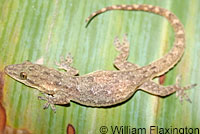 |
 |
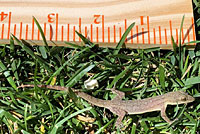 |
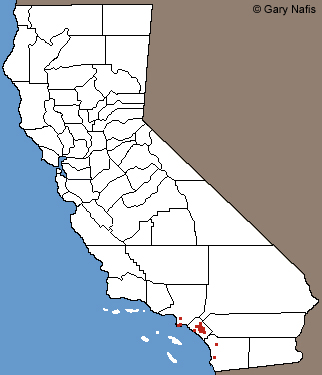 This lizard continues to expand its range in California. Red dots on the map indicate some of the areas where it has been found and could be established. |
||||||
| Adult in light phase, Orange County © William Flaxington |
Adult in dark phase, Florida © John Sullivan |
Adult, Orange County | |||||||
| A small gecko with sticky toe pads and large eyes with vertical pupils and no eyelids. The snout is relatively long and thin, longer than the distance between the eye and the ear-opening (similar to that of a fox, which explains the name Fox Gecko.) A single saw-tooth row of enlarged, spine-like scales along the lateral edge of the tail. The skin is smooth, but not shiny. Adults are 4 - 5.5 inches in length (10 - 14 cm) including the tail. Generally brown or gray in color, sometimes marbled with darker brown. Darker in the daytime, becoming pale and almost translucent at night. Small whitish dorsal spots of varying sizes and shapes. Sometimes there are faint cross-bands on the tail. The belly is often lemon-yellow and the underside of the tail is sometimes pale red. |
Activity is almost completely nocturnal. This gecko is native to South and Southeast Asia, the East Indies, and many South Sea islands, including Northeast India, Bangladesh, Nepal, Myanmar, Thailand, the Malaysian Peninsula, Southern China, Taiwan, the Philippine Islands, Indonesia, New Guinea, new Caledonia, Polynesia, Fiji, Western Samoa, Vanuatu, the Cook Islands, and Tonga. It has been established in Florida, Georgia, Hawaii, Texas and California, and in the Bahamas and Costa Rica. In California, so far found in: Torrance, Los Angeles County; Lake Forest, Orange County; and Orange, Orange County. |
Eats a variety of invertebrates including insects and spiders. This species is all female. Reproduction is by parthenogenesis - the development of unfertilized eggs. One individual is capable of establishing a new population. Eggs are laid in pairs in dark places such as crevices, moist soil, and in crevices. Associated with human development, mostly found on buildings with outdoor lights. |
|||||||
| Tropical House Gecko Hemidactylus mabouia Not Native to California Please email me if you see this species in the wild in California, and send pictures if you can. |
|||||||||
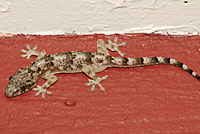 |
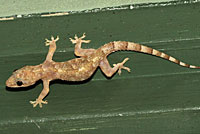 |
 |
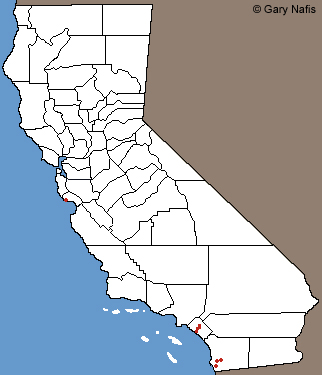 This lizard continues to expand its range in California. Red dots on the map indicate some of the areas where it has been found and could be established. |
||||||
| Adult in dark phase | Adult in light phase | Adult in light phase | |||||||
| A medium-sized lizard with a slender body, large eyes with vertical pupils, and a flat head that is wider than the neck. The body is moderately warty, with scattered dorsal tubercles which are not very prominent. Color is pale, pinkish, gray, or brown, with four or five rear-facing dark chevron-like markings that fade when exposed to light for prolonged periods. When a gecko is in its pale phase there is still a trace of the chevron markings. The chevron markings will distinguish the species from other Hemidactylus geckos found in California. |
Nocturnal. Takes advantage of artificial light sources to hunt flying insects attracted to the light. Arboreal - enlarged toe pads make them excellent climbers. Territorial, aggressive, and fairly sedentary, with a small home range. So far, established in a few locations in Orange County and San Diego County. Typically found on buildings in urban areas. |
Eats a variety of invertebrates, including spiders, flies, crickets, cockroaches, centipedes, beetles, moths, caterpillars, isopods, and grasshoppers. Also eats hatchlings of other lizard species. Hunts by sitting and waiting for prey to come close. Females lay two eggs several times per year.
|
|||||||
| Flat-tailed House Gecko Hemidactylus platyurus Not Native to California |
|||||||||
 |
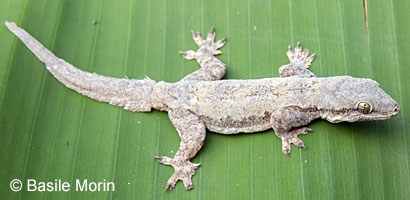 |
 Red: Some general locations where this Red: Some general locations where this gecko may be established |
|||||||
| Adult, Orange County © William Flaxington |
Adult, Don Det, Si Phan Don, Laos © Basile Morin (cropped thumbnail - click photo to see original) |
||||||||
| A small species with a short stout body, a large head with a long snout, well-developed limbs, and a broad flat tail with a serrated edge. The toes have adhesive pads for climbing and the toes are partially-webbed. Eyes with vertically elliptical pupils and no moveable eyelids. Adults are about 2.7 inches (69mm) long from snout to vent. The tail is about equal to the body length. They are also reported to grow to about 6 inches (15 cm) in total length, with thee tail about half of the length. |
Color is gray-brown, cream, tan, or gray. Typically there is a dark line from behind the eye that continues in a dark stripe on the lateral edge of the body. Changes color from a darker color with bark-like markings in the dark phase to an almost patternless cream color in the light phase at night. The body and rear legs are edged with skin flanges. "When the lateral flanges are spread outward, this little lizard casts little if any shadow, hence is nearly invisible against many natural backgrounds." (Bartlett & Bartlett). Young have more well-defined bands around the tail. |
Nocturnal. Arboreal. An excellent climber, able to climb vertical walls and walk on ceilings. Often observed on the walls of buildings at night where it is attracted to external lights and feeds on the invertebrates attracted to the lights. In California, found on buildings in urban areas. Found in several locations in coastal southern California, including Los Angeles County Orange County San Diego County |
|||||||
| Mediterranean Gecko Hemidactylus turcicus Not Native to California |
|||||||||
Video |
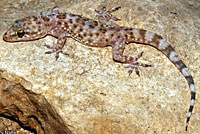 |
 |
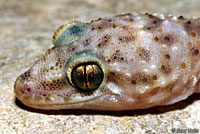 |
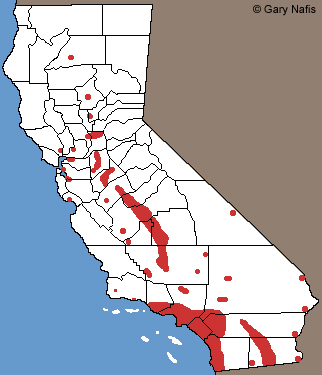 This lizard continues to expand its range in California. Red marks on the map indicate some of the areas where it has been found and could be established. |
|||||
| Gecko in light phase | Same gecko in dark phase | ||||||||
 |
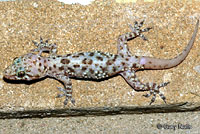 |
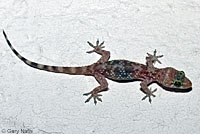 |
|||||||
| 1.75 to about 2.5 inches long, not including the tail. 4 to 5 inches long with the tail. A small, slightly flattened lizard with conspicuous large bumpy tubercles on the skin and large eyes with vertical pupils. Two color phases. Light phase is pale pinkish white with dark blotching and spotting sometimes forming indistinct bands. Dark phase is dark brown or gray with darker markings and bands. The tail is ringed with dark and light bands. |
Nocturnal. Native to the Mediterranean region. Has become increasingly common in southern California since the year 2000.Typically spread from place to place in shipments of goods and lumber. Found living in or near human dwellings, but probably also found in surrounding habitats. Recorded from many locations in Southern California, but probably established in many more areas, and spreading. |
Eats a variety of small invertebrates. Females lay eggs from April to August. Typically seen on the outside wall of a building at night under a light, where they catch flying insects. May also be seen on walls indoors. |
|||||||
| Italian Wall Lizards Podarcis siculus Not Native to California Please email me if you see this species in the wild in California, and send pictures if you can. |
|||||||||
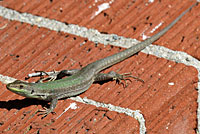 |
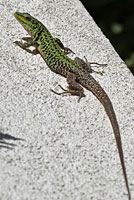 |
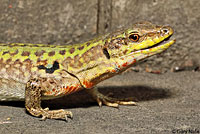 |
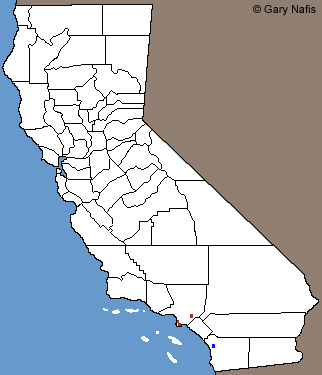 Red dots on the map indicate the two areas where this species has been documented as established. |
||||||
| A medium-sized lizard with a long slender body with a large deep head, muscular limbs, and a tail up to twice the length of the body. Adults grow up to 3.5 inches long from snout to vent (9 cm). Highly variable in appearance - above is typically green, yellowish, olive, or light brown. Some individuals change from green to brown in the summer. The sides are often reticulated or checkered. These markings may extend over the back. |
Diurnal Native to the Mediterranean region of Italy, France, Spain, Turkey, and several islands. Spread by the release or escape of captive pets. In its native range, this lizard is found in grassy areas, road edges, open fields, the edges of woods, sandy areas, near the sea, and vineyards. Often found around human structures, in domestic gardens and in parks. |
Eats small invertebrates and vegetable matter. Breeds in the Spring. Females lay up to 5 clutches of 2 - 12 eggs which hatch in 5 - 7 weeks. So far, found established only in San Pedro and San Marcos. |
|||||||
| Ringed Wall Gecko Tarentola annularis Not Native to California Please email me if you see this species in the wild in California, and send pictures if you can. |
|||||||||
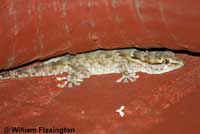 |
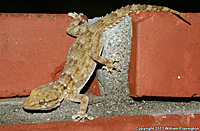 |
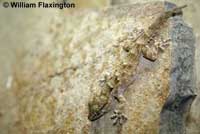 |
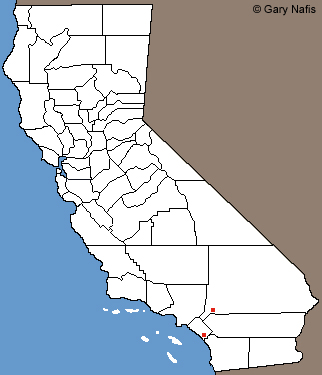 So far this species has only been established in Redlands, San Bernardino county. |
||||||
| Adult, San Bernardino County © William Flaxington |
Adult, San Bernardino County © William Flaxington |
Adult, San Bernardino County © William Flaxington |
|||||||
| A robust-bodied lizard with rows of large rough tubercular scales covering the back, raised scales covering the limbs and tail, and elongated toes. Adults grow up to 6 inches (15.2 cm) in total length. Color is gray or tan. Usually with 4 distinctive white spots with dark borders on the shoulders. These are the white spots which give this species its name. |
Nocturnal. Prey includes invertebrates and small lizards. Native to parts of northern Africa. |
In its native range, females produce several sets of 2 eggs each season. In California, found on urban buildings and in urban alleys. So far, found established only in Redlands, San Bernardino County. |
|||||||
| Moorish Gecko Tarentola mauritanica Not Native to California Please email me if you see this species in the wild in California, and send pictures if you can. |
|||||||||
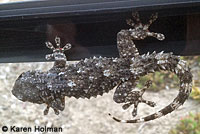 |
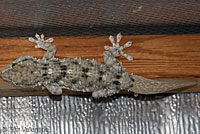 |
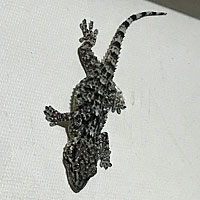 |
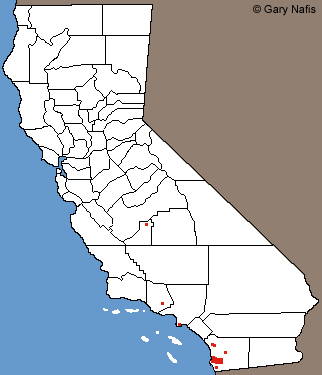 This lizard continues to expand its range in California. Red dots on the map indicate some of the areas where it has been found and could be established. |
||||||
| Adult, San Diego County © Karen Holman |
Adult with regenerated tail, San Diego County © Tim Valentine | Adult, San Diego County | |||||||
| A robust-bodied lizard with a flat head, prominent tubercles on the upper surfaces, large bulging eyes with vertical pupils and no eyelids, and elongated toe pads. The tail is easily detached, but it will regenerate. Regenerated tails do not grow tubercles. Adults grow up to 6 inches long (15 cm) including the tail. Moorish Geckos are usually around 3.2 inches long (8 cm) from snout to vent. Color is brownish, grey or sandy with dark and light markings. Color changes from dark during daytime to light phase at night. The underside is white to yellow. Young geckos have dark bands. |
Nocturnal, but also known to bask in the sun during cooler parts of the year. Often seen foraging for food under artificial light sources. A good climber. The species is native to the coastal Mediterranean area of Europe and Africa. Geckos in California could have originated as escaped pets or they could have been transported from wild populations, probably from Florida originally, and then from other California populations. |
Eats small invertebrates and possibly small vertebrates. In its native habitat, 2 - 3 clutches of 1 or 2 eggs are laid around April and June. Moorish Wall Geckos take several years to reach sexual maturity. Found in its native habitat on stone walls, boulders, and piles of wood in warm, dry, lowland coastal areas. Non-native populations are typically found on inside and outside walls and cinderblock fences. |
|||||||
| African Five-lined Skink Trachylepis Quinquetaeniata Not Native to California and Possibly Now Eradicated Please email me if you see this species in the wild in California, and send pictures if you can. |
|||||||||
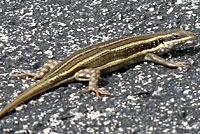 |
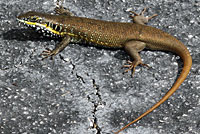 |
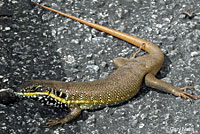 |
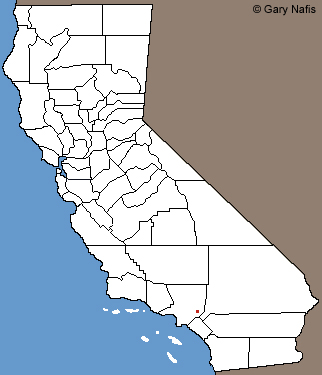 Red dots on the map indicate where this species was originally established in the San Gabriel Valley in eastern Lost Angeles County. |
||||||
| Adult female | Adult male | Adult male | |||||||
| A medium-sized stocky lizard with a cylindrical body and a pointed snout Coloration is variable, depending on the gender and the age. Females and juveniles are striped, adult males are not.
|
Primarily terrestrial. Diurnal, often seen basking in the sun on the ground or on low ground objects. Eats insects, flowers, fruit, small lizards. |
Lays eggs in summer that hatch in late summer/early fall. Native to Africa. Established in Florida. So far (3/21) only established in suburban neighborhoods in the San Gabriel Valley, including Glendora. |
|||||||
| Yellow Fan-fingered Gecko Ptyodactylus hasselquistii Not Native to California Please email me if you see this species in the wild in California, and send pictures if you can. |
|||||||||
 |
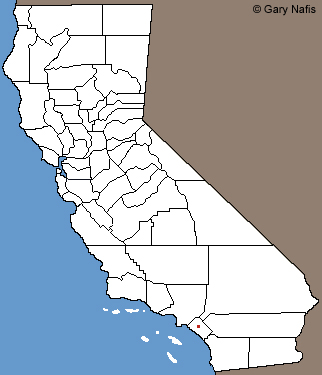 Red dot shows where this species is established in Santa Ana, Orange County. |
||||||||
| © 2009 Frank Teigler - CalPhotos | |||||||||
| A slim nocturnal gecko
with long thin hind limbs and very large feet. Color is golden brown, cream, gray, tan, or pinkish, and at night appears almost white. The body is marked with darker cross-bands and spots. The tail is banded. The eyes are large without eyelids, and the pupils are vertical. Adults grow to a snout to vent length of 3.8 inches (96mm). An excellent climber, able to climb on most surfaces, including ceilings. In its native range this species is found in rocky arid deserts, also utilizing human structures. The lone California population is in an urban setting where they live on buildings. |
|||||||||
| Turtles | |||||||||
Most turtles in coastal Southern California are active during warm and sunny weather, typically from about late February through October, but sometimes they are active all year. |
|||||||||
| Southwestern Pond Turtle Actinemys pallida |
|||||||||
Video |
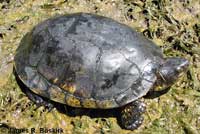 |
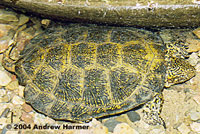 |
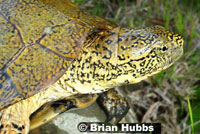 |
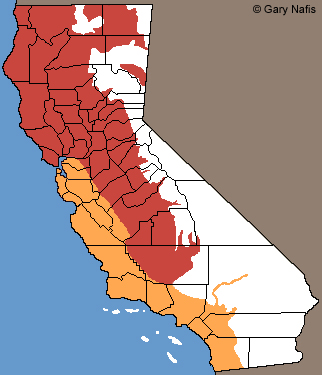 Range shown in Orange Range shown in Orange |
|||||
| The shell is typically 3.5 to 8.5 inches long. Hatchlings are abut 1 inch long. A dark brown, olive, or black turtle with a low un-keeled shell, usually with a pattern of lines or spots radiating from the centers of the scutes. The head and neck are light in color with dark mottling. |
Diurnal. Maybe be common in some areas, but declining. Found in ponds, lakes, rivers, streams, creeks, marshes, and irrigation ditches with abundant vegetation in a variety of areas including woodland, forest, grassland, and parks. Rarely seen away from water. Often seen basking just above the water |
Eats aquatic plants, bugs, worms, frog eggs and tadpoles, salamander eggs and larvae, crayfish, carrion, and occasionally frogs and fish. Females crawl onto land and lay eggs between April and August. |
|||||||
| Green Sea Turtle Chelonia mydas |
|||||||||
Video |
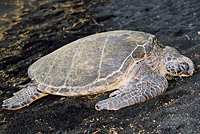 |
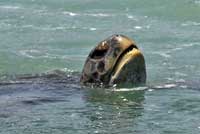 |
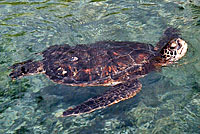 |
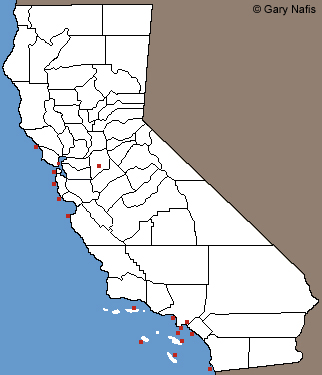 Locations where Green Sea Turtles have been recorded are shown in Red. |
|||||
| The shell is 30 to over 60 inches long. A large sea turtle with powerful paddle-like forelimbs and a broad, low, smooth, heart-shaped shell. The shell is green, olive, brown, gray, or black, sometimes with a mottled or radiating pattern. Green fat, not body coloring, gives this turtle its name. |
Diurnal. Rare in our area, but found regularly in San Diego Bay and in the mouth of the San Gabriel River. Found in the ocean, feeding in lagoons, bays, estuaries, eelgrass and seaweed beds where there is abundant aquatic vegetation in shallow protected water. Mostly aquatic, rarely coming onto land. |
Eats seaweed, algae, and marine invertebrates including sponges and jellyfish. Females crawl onto sandy shores and lay eggs any time between February and January depending on the location. Young hatch at night and immediately crawl into the ocean. |
|||||||
| Loggerhead Sea Turtle Caretta caretta |
|||||||||
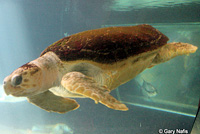 |
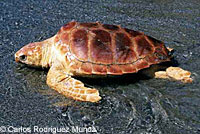 |
 |
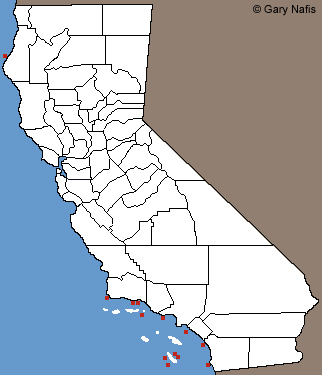 Locations where Loggerhead Sea Turtles have been recorded are shown in Red. Locations where Loggerhead Sea Turtles have been recorded are shown in Red. |
||||||
| Adults are about 33 to 39 inches long, weighing about 300 lbs. A large sea turtle with a broad head, a thick bony shell, and huge paddle-like limbs. Reddish or orange-brown with yellow edging around the shields. Head and limbs are reddish to olive brown with many yellow-bordered scales. |
Rare - occasionally found along the coast. Aquatic. Lives in the open ocean, entering bays, lagoons, marshes, estuaries, creeks, and large river mouths, but rarely coming onto land. |
Eats a wide variety of marine plants and animals, including sponges, crustaceans, mollusks, jellyfish, worms, cephalopods, bivalves, barnacles, shrimp, and fish. Females lay eggs on sandy beaches, often traveling over a thousand miles to get there. Eggs hatch in 46 to 80 days and hatchlings immediately crawl into the sea. |
|||||||
| Leatherback Sea Turtle Dermochelys coriacea |
|||||||||
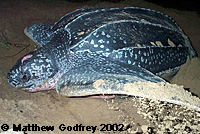 |
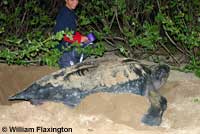 |
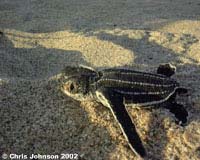 |
 Locations where Leatherback Sea Turtles have been recorded are shown in Red Locations where Leatherback Sea Turtles have been recorded are shown in Red |
||||||
| The largest turtle on Earth, averaging 48 to 96 inches in shell length, and weighing 600 to 1,600 lbs. A huge sea turtle with smooth leathery skin, a large head, and large paddle-like limbs. Dark brown, slate, or blue-black, sometimes with pale blotches. |
Rare - occasionally found along the coast. Pelagic, living in the open ocean, occasionally entering bays and estuaries. |
Eats mostly jellyfish, along with some marine plants, and marine invertebrates and vertebrates, including sea urchins, snails, octopi, squid, crabs, and small fish. Females lay eggs on sandy beaches. Eggs hatch in 60 to 65 days. Hatchlings dig to the surface and crawl immediately into the ocean. Those found in California waters have been found to nest across the entire Pacific ocean in Indonesia, New Guinea, and the Solomon Islands. |
|||||||
| Pacific Hawksbill Sea Turtle Eretmochelys imbricata bissa |
|||||||||
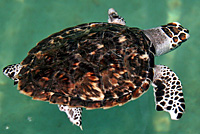 |
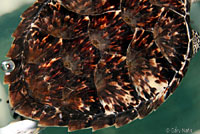 |
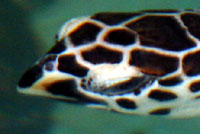 |
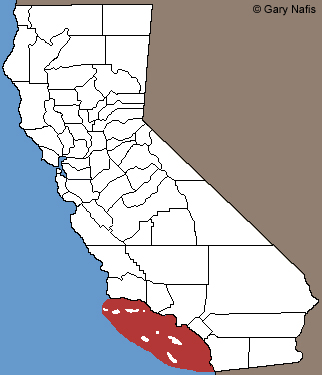 Locations where Pacific Hawksbill Sea Turtles have been recorded are shown in Red Locations where Pacific Hawksbill Sea Turtles have been recorded are shown in Red |
||||||
| Adults are 18 to 36 inches long and up to 280 lbs. A medium-sized sea turtle with large paddle-like limbs. Dark greenish brown with a marbled or radiating pattern. Head is black to chestnut brown in the center with light margins. |
Very rare in our area. Pelagic, inhabiting shallow coastal waters in rocky places, rarely entering land. |
Eats invertebrates, mostly sponges, along with mollusks, jellyfish, corals, sea anemones, sea urchins, crabs, rock lobster, fish, algae, sea grasses, and mangroves. Females lay eggs on sandy beaches. Eggs hatch in 6- to 70 days and hatchlings dig to the surface and immediately crawl into the ocean. |
|||||||
| Olive Ridley Sea Turtle Lepidochelys olivacea |
|||||||||
Video |
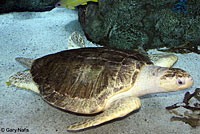 |
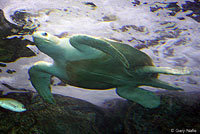 |
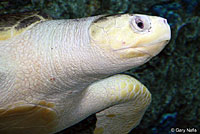 |
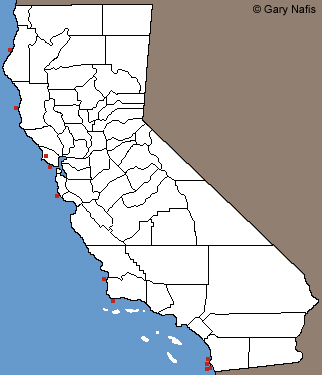 Locations where Olive Ridley Sea Turtles have been recorded are shown in Red Locations where Olive Ridley Sea Turtles have been recorded are shown in Red |
|||||
| The smallest sea turtle. Adults are 20 to 29 inches in length. A small sea turtle with a round, flat shell, a large triangular head, and large paddle-like limbs. The shell is olive to grayish green and the skin is gray. |
Rare in our area. Pelagic, found in open ocean and in bays, lagoons, and shallow waters offshore. |
Mostly carnivorous. Eats mollusks, crustaceans, jellyfish, sea urchins, crab, fish, sea urchins, snails, and occasional plant material - algae, seagrass, and seaweed. Females lay eggs on sandy beaches. Eggs hatch in 45 to 70 days. Hatchlings dig to the surface and immediately crawl into the ocean. |
|||||||
Established Turtles Not Native to California |
|||||||||
| Red-eared Slider Trachemys scripta elegans Not Native to California |
|||||||||
Video |
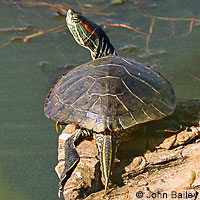 |
 |
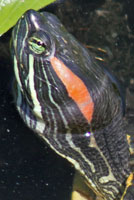 |
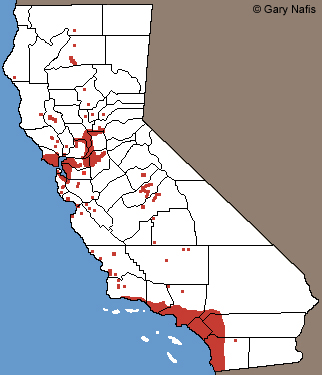 Range shown in Red Range shown in Red |
|||||
| © John Bailey | |||||||||
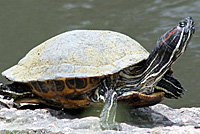 |
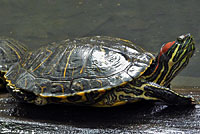 |
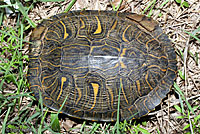 |
|||||||
| The shell is 3.5 to 14.5 inches long. The shell is olive, brown, or black in color with streaks and bars of yellow or eye-like spots. The skin is green to olive brown with yellow markings and a prominent broad red stripe behind the eye. |
Diurnal. Common, but not native. Found in sluggish rivers, ponds, shallow streams, marshes, lakes, reservoirs, and urban park ponds. |
Females crawl onto land and lay eggs between April and July. Eats crustaceans, mollusks, fish, insects, snails, tadpoles, and aquatic plants. May be active on sunny days in winter. |
|||||||
| Yellow-bellied Slider Trachemys scripta scripta Not Native to California Please email me if you see this species in the wild in California, and send pictures if you can. |
|||||||||
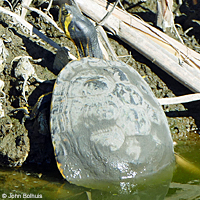 |
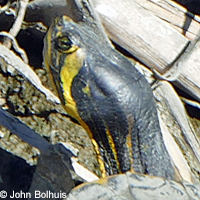 |
 |
 Range shown in Red Range shown in Red |
||||||
| © John Bolhuis | |||||||||
| A medium to large freshwater turtle. Related to the much more numberous Red-eared Slider. The carapace is black and brown often with yellow stripes. Skin is olive green with patches of yellow on the legs and neck. The backs of the hind limbs are marked with vertical yellow stripes and the front of the forlimbs are marked with narrow yellow stripes. The name is derived from the yellow plastron (underside) which has round dark markings on the edges. Adults tend to grow darker in color as they get older.. |
Diurnal Semi-aquatic, spending much time in bodies of water, but also travels overland during dry seasons to locate a new water source and during the breeding season to find mates. Females also move overland to find a site to lay eggs. Tolerant of fairly dirty and even brackish water. Feeds mostly in the morning before basking on logs, shorelines, or while floating. Sleeps at night on the water bottom or on the surface near surface vegetation to hide under such as brush piles or mats of algae. Basks out of the water on banks, rocks, logs, or other exposed objects, often in large groups, and sometimes stacked one upon another. |
Omnivorous, eating leaves, roots, fruits, and stems of aquatic plants, aquatic invertebrates, snails, insects, crustaceans, mollusks, and vertebrates including fish, frogs, and tadpoles. Hatchlings are primarily carnivorous, but consume progressively larger amounts of vegetation as they mature. As they grow older, adults eat less meat, with most of their diet consisting of plants. Found in a wide variety of habitats in its native range, mostly in calm fresh water areas with abundant aquatic vegetation, such as sluggish rivers, ponds, shallow streams, marshes, lakes, and reservoirs. Also been known to tolerate the brackish waters and survive in coastal waterways. Found in similar habitat in California, mostly in areas with heavily-populated areas. |
|||||||
| Western Painted Turtle Chrysemys picta bellii Not Native to California Please email me if you see this species in the wild in California, and send pictures if you can. |
|||||||||
Video |
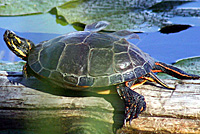 |
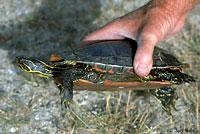 |
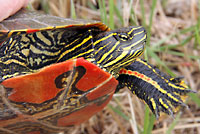 |
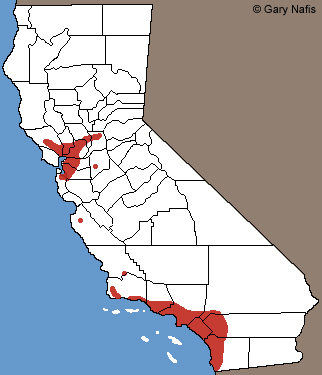 Range shown in Red |
|||||
| 2.5 to 10 inches long. A small turtle with red markings on the bottom and no red markings on the sides of the head. The shell is black, brown, or olive in color with a network of faint light lines, and olive, yellow, or red borders on the shields. The head and limbs are olive or black with yellow lines. |
Diurnal. Uncommon. The most widespread species of turtle in North America, but not native to California. Aquatic. Found in ponds, marshes, lakes, ditches, and quiet streams. |
Eats almost anything it can find, including insects, worms, snails, crayfish, fish, amphibians and tadpoles, carrion, and aquatic vegetation. Females lay eggs on land between May and August. |
|||||||
| Snapping Turtle Chelydra serpentina Not Native to California Please email me if you see this species in the wild in California, and send pictures if you can. |
|||||||||
Video |
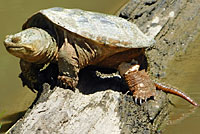 |
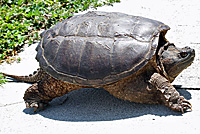 |
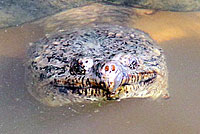 |

Red dots = Some locations of Snapping Turtle sightings in California |
|||||
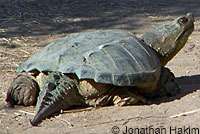 |
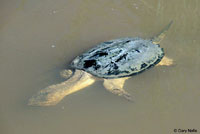 |
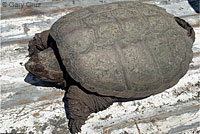 |
|||||||
| © Jonathan Hakim | © Gary Cruz | ||||||||
| 8 - 18.5 inches in shell length A large freshwater turtle with a massive head with huge hooked jaws, a long tail, a saw-toothed crest, and a shell that looks like it is too small to fit the body. The legs are large with webbed toes and heavy claws. The tail is longer than half the length of the carapace. Average weight is around 45 lbs, but some captives have weighed in at over 75 lbs. The skin is gray, black, yellow, or tan, with tubercles on the neck. White flecks occur on some individuals. |
The color of the shell ranges from black, brown, or olive to tan. The shell is often covered with mud or algae, which helps camouflage the turtle. The shell is heavily serrated on the rear edge, and scutes may have a pattern of radiating lines. Active most of the year, becoming dormant in areas with cold winters, generally in late October. Remains dormant either burrowed into the mud bottom, or under overhanging banks, root snags, stumps, brush, logs, or other debris. Aquatic, found in or near water. An excellent swimmer. |
Sometimes seen basking on or under the surface in shallow water. Often rests buried in the mud with its eyes and nostrils exposed in water shallow enough that it can raise its long neck up to allow the nostrils to break the surface and breathe without moving out of the mud. Females crawl onto land, sometimes traveling over great distances, to dig a nest where they lay a clutch of eggs. Egg laying takes place mostly in June and July (but can occur any time between May and October). The eggs hatch in 9 - 18 weeks. |
|||||||
| Texas Spiny Softshell Apalone spinifera emoryi Not Native to California |
|||||||||
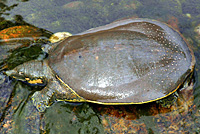 |
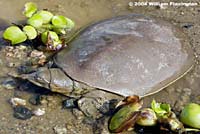 |
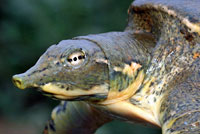 |
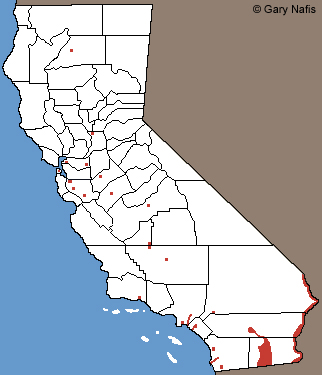 Range shown in Red |
||||||
| The shell is 5 to 21 inches long. A flat turtle with a rounded, leathery shell without visible scutes and a long snout with open nostrils on the end. The shell is olive, brown, or gray in color, sometimes with dark markings that fade with age. The head and limbs are olive to gray with dark markings and two light stripes mark each side of the head. |
Diurnal. Uncommon and not native to our area. Found in permanent rivers, agricultural canals, drainage ditches, artificial lakes, and ponds. |
Eats insects, crayfish, worms, snails, fish, frogs, and tadpoles. Females crawl onto land and lay eggs between May and August that hatch between August and September. |
|||||||
| River Cooter Pseudemys concinna Not Native to California |
|||||||||
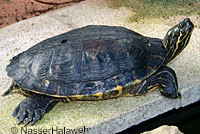 |
 |
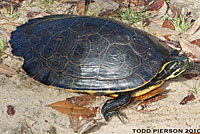 |
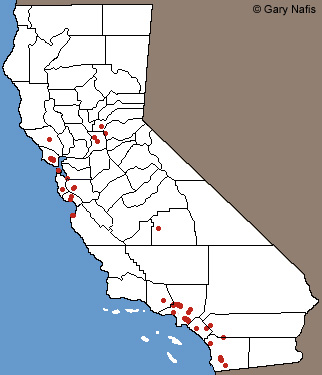 Red: Some locations where this species has been reported. |
||||||
| Adult Eastern River Cooter, Hannover Germany © NasserHalaweh 2010 Used under license CC BY-SA 4.0 (Copyright was added. Image was cropped for close-up and thumbnails.) |
Adult, Georgia © Todd Pierson 2011 Used under license CC BU-NC 3.0. (Image was cropped and re-sized for thumbnail.) |
||||||||
A large mostly-aquatic freshwater diurnal turtle found in rivers, lakes, and ponds. Typically observed when basking on rocks, logs, or shores.
|
Diurnal Typically seen basking in the sun on logs and rocks, often with other aquatic turtles. Quickly slips into the water when disturbed. Found in artificial lakes and ponds in California. Inhabits rivers with strong currents in its native range. |
In California, observed mainly in densely-populated areas in the S.F. Bay Area, the Los Angeles Basin, the Sacramento area, and in San Diego County, the result of illegally released unwanted pets. It is not known yet if it has been established and breeding in any location other than at Otay Lake in San Diego County. Due to its shy behavior that makes it difficult to observe, probably found in many more locations. |
|||||||
| Frogs and Toads | |||||||||
Frogs and toads in coastal Southern California can be active most of the year, except during very hot and very cold weather. However, even during hot and dry weather, some species can be seen floating in water. |
|||||||||
| California Toad Anaxyrus boreas halophilus (formerly Bufo boreas halophilus) |
|||||||||
Call Video |
 |
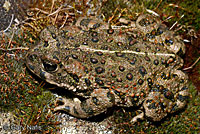 |
 |
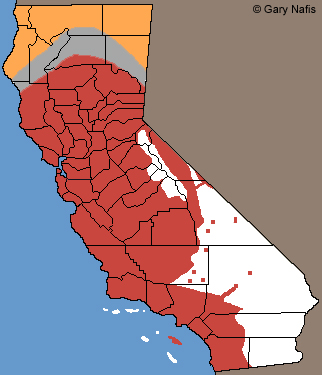 Range shown in Red and Gray |
|||||
| Adults are 2 to 5 inches long. A large squat toad with dry warty skin. Color is greenish, tan, reddish brown, gray, or yellowish with irregular dark blotches and a light-colored stripe down the middle of the back. Warts on the back are often on dark blotches. |
Diurnal in cool weather, Nocturnal in hotter weather. Common where found but less common in urbanized areas. Found in a variety of areas including marshes, springs, creeks, ponds, small lakes in woodland, forest, and grassland. The only species of toad found in our area. |
Eats a wide variety of invertebrates. Females lay eggs in water some time between January and July, depending on the location, rainfall, and snowmelt. Eggs hatch into tadpoles in about a week or two. Tadpoles live in the water then transform into tiny toads and move onto land in about 1 to 1.5 months. Active mostly late Winter through Fall except during extreme cold and extreme heat when it stays in moist shelters. |
|||||||
| Arroyo Toad Anaxyrus californicus (formerly Bufo californicus) |
|||||||||
Call |
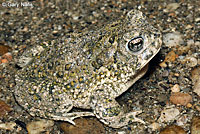 |
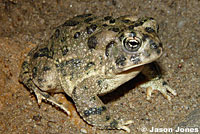 |
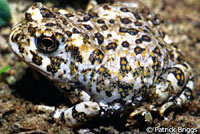 |
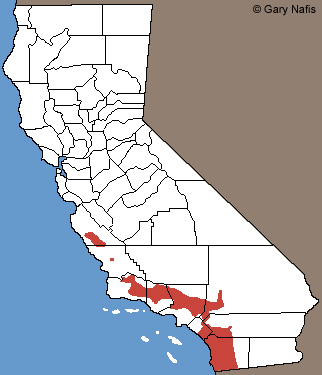 Range shown in Red Range shown in Red |
|||||
| Adults are roughly 2 to 3 inches long. A plump and stocky toad with dry and warty skin. Greenish, gray, olive, or dull brown in color, with no light stripe down the middle of the back, and light and dark spots. |
Mostly Nocturnal. Uncommon due to rare and vanishing habitat. Found along sandy riverbanks, typically lined with willows, sycamores, oaks, and cottonwoods from sea level to about 3,000 ft. Seriously threatened by loss of habitat largely due to development and human recreation along sandy creeks. |
Eats mostly ants and a wide variety of other invertebrates. Females lay eggs in water in quiet stream edges from March to July. Eggs hatch in 4 to 6 days. Tadpoles live in the water until they transform into tiny toads and move onto land in about 72 to 80 days, mostly in the late spring. |
|||||||
| Baja California Treefrog Pseudacris hypochondriaca hypochondriaca (formerly Hyla regilla - Pacific Treefrog) |
|||||||||
Call Video |
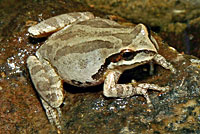 |
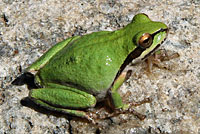 |
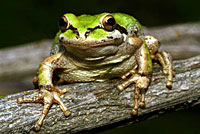 |
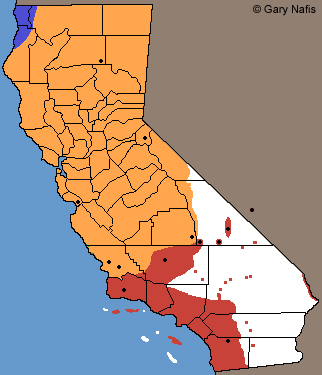 Range shown in Red Range shown in Red |
|||||
| Adult frogs are 3/4 to 2 inches long. A small frog with smooth skin, a large head and eyes, round pads on the toe tips, and a wide dark stripe through the middle of each eye. Various colors and patterns. Most frogs are green or brown in color overlaid with irregular dark markings, but some frogs are, gray, reddish, or cream in color. |
Diurnal and Nocturnal. The most commonly seen frog in our area. Found almost anywhere there is water for breeding, including forest, woodland, chaparral, grassland, pastures, streams, and urban areas. |
Eats a wide variety of invertebrates, including flying insects. Females lay eggs in water some time between November and July. Eggs hatch into tadpoles in 2 to 3 weeks. The tadpoles live in water then transform into tiny frogs and move onto land 2 to 2.5 months later. Active most of the year except during extreme cold and extreme heat when it stays in moist shelters. |
|||||||
| California Treefrog (or Chorus Frog) Pseudacris cadaverina |
|||||||||
Call Video |
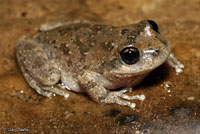 |
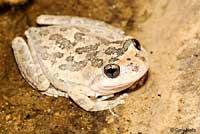 |
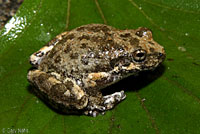 |
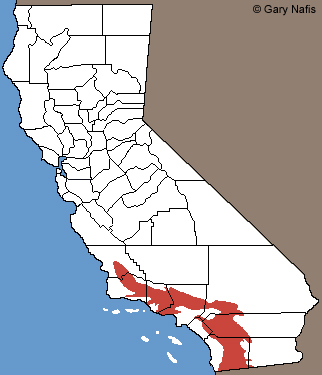 Range shown in Red |
|||||
| Adults are 1 to 2 inches long. A small treefrog with rough skin and large pads on the toes. Gray or brown with dark blotches. No dark stripe through the eye. |
Diurnal and Nocturnal. Common where it occurs in rocky creeks.Often heard calling at night between February and October. Found in rocky streams in canyons, and washes with permanent quiet pools from sea level to 7,500 ft. |
Eats insects, spiders, centipedes and other invertebrates. Females lay eggs in water between February and October. Tadpoles live in water for 40 to 75 days then transform into tiny frogs and move onto land. |
|||||||
| California Red-legged Frog Rana draytonii |
|||||||||
Call Video |
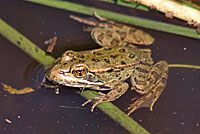 |
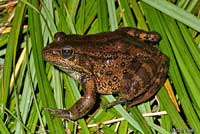 |
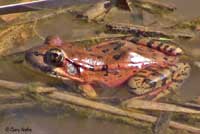 |
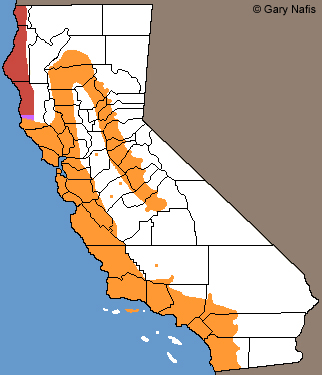 Range shown in Orange |
|||||
| Adults are about 2 - 5 inches long. A medium-sized frog with smooth skin and a visible line on the sides of the back and a wide dark marking behind each eye. Reddish-brown, brown, gray, or olive in color with small black flecks and spots on the back and sides and dark bands on the legs. Red coloring underneath the rear legs. |
Diurnal and Nocturnal. Rare and almost extinct in Southern California. Found mainly in and near ponds in a variety of habitats, including forest, woodland, grassland, coastal scrub, and streams, but sometimes found far away from water. |
Eats a variety of invertebrates, and occasionally small vertebrates such as fish, mice, frogs, and salamander larvae. Females lay eggs in water some time from November to April depending on the location. Eggs hatch into tadpoles in about a month. Tadpoles live in the water then transform into tiny frogs and move onto land 4 to 6 months later, or sometimes not until the following summer. Mostly active late Winter through Fall. |
|||||||
| Southern Mountain Yellow-legged Frog Rana muscosa |
|||||||||
Video |
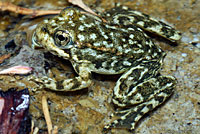 |
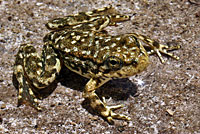 |
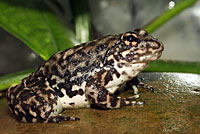 |
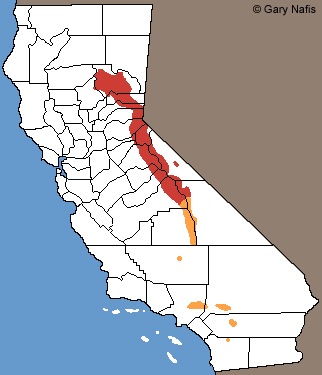 Range shown in Orange |
|||||
| Adults are 1.5 to 3.5 inches long. Color is variable - olive, yellowish or brown above, with varying amounts of black or brown markings. No dark mask on the face. |
Diurnal. Rare and almost extinct. Captive breeding is being done to try to re-establish frogs in some areas. Found only in mountain streams in the San Gabriel, San Bernardino, and San Jacinto Mountains from about 1,000 to 12,000 ft. in elevation. |
Eats a variety of terrestrial and aquatic invertebrates, including beetles, ants, bees, wasps, flies, and dragonflies. Females lay eggs in water after high creek waters have subsided, from March to May. Tadpoles may live in the water for as much as 3 or 4 summers before they transform into tiny frogs and move onto land. |
|||||||
| Western Spadefoot Spea hammondii |
|||||||||
Call |
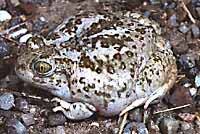 |
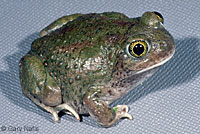 |
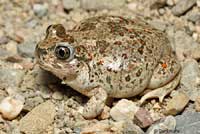 |
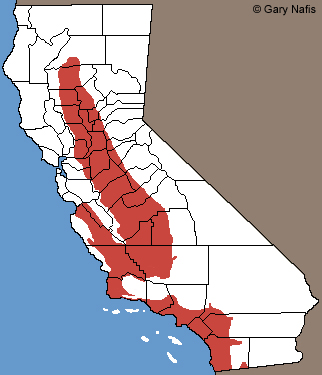 Range shown in Red Range shown in Red |
|||||
| Adults are 1.5 to 2.5 inches long. A fat squat spadefoot with large eyes with vertical pupils. Color is greenish, brown, gray, or cream. Typically there are reddish spots, dark markings and 4 irregular light stripes on the back. |
Nocturnal. Common in some areas, but rarely seen. Spends most of its life underground. Found in open areas with sandy or gravelly soils in various habitats, including mixed woodlands, grasslands, coastal sage, chaparral. |
Eats a variety of invertebrates, including beetles, moths, crickets, flies, ants, and earthworms. Females lay eggs in water some time between January and May after heavy rainfall creates temporary pools of water. Eggs hatch into tadpoles in about 3 to 6 days. Tadpoles live in water then transform into tiny spadefoots and move onto land in 4 to 11 weeks, depending on how long it takes for the pool to dry up. Surface active only during rains, typically January to May in our area. |
|||||||
Established Frogs Not Native to California |
|||||||||
| Southern Leopard Frog Lithobates sphenocephala Not Native to California Please email me if you see this species in the wild in California, and send pictures if you can. |
|||||||||
Call Video |
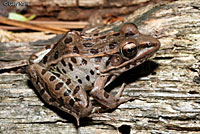 |
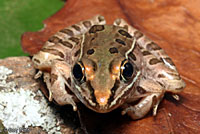 |
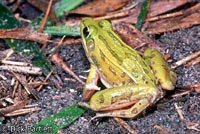 |
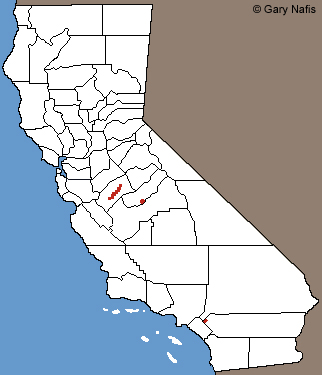 Range shown in Red Range shown in Red |
|||||
| Adults are 2 to 3.5 inches long. A medium-sized leopard frog with a long pointed snout. Brown or greenish with large dark spots bordered with light color, striping on the legs, and a visible ridge line on the upper sides. |
Mostly nocturnal. Rare in our area and not native. |
Eats a wide variety of invertebrates, including crayfish. Females lay eggs in water. In its natural habitat, breeding occurs in early spring in the Northeast, and during any month of the year in the South. Eggs hatch somewhere between 4 days and 2 weeks. Tadpoles live in the water for 50 to 75 days then transform into tiny frogs and move onto land. |
|||||||
| American Bullfrog Lithobates catesbeianus Not Native to California |
|||||||||
Call Video |
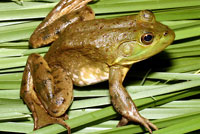 |
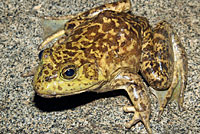 |
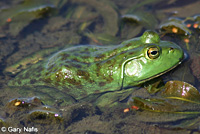 |
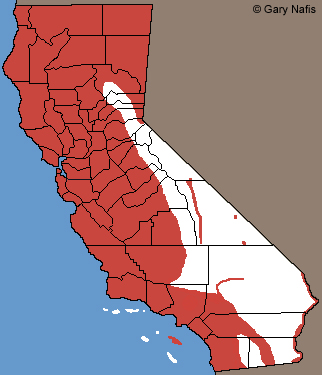 Range shown in Red |
|||||
| Adults are 3.5 to 8 inches long. The largest frog found in our area. A large frog with smooth skin and no lines on the sides of the back, and conspicuous eardrums. Light green to dark olive green in color with irregular dark spots and blotches. Juveniles have many small dark spots. |
Diurnal and Nocturnal. Common, but not native to our area. Found in permanent water - lakes, ponds, sloughs, reservoirs, marshes, slow rivers, irrigation canals, cattle tanks, and slow creeks, in almost any habitat which is open and sunny, including grassland, farmland, prairies, woodland, forests, and chaparral. |
Eats anything it can swallow, including invertebrates, mammals, birds, fish, reptiles, and amphibians. Females lay eggs in water typically between May and August. Eggs hatch into tadpoles 3 to 5 days. Tadpoles live in water and grow very large, not turning into small frogs and moving onto land until anytime between a few months and a year to two years. Mostly active late Winter through Fall. |
|||||||
| African Clawed Frog Xenopus laevis Not Native to California |
|||||||||
Call |
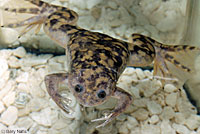 |
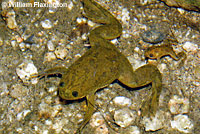 |
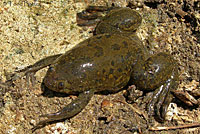 |
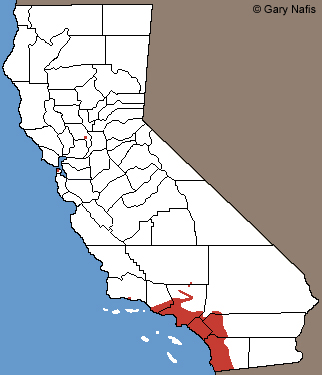 Range shown in Red Range shown in Red |
|||||
| Adults are 2 to almost 6 inches long. A medium-sized frog with smooth skin, a flattened body, and a small head with a blunt snout and upturned eyes with no lids. Olive to brown in color with irregular dark markings. Rarely leaves water, but will move overland on rainy nights when ponds dry up. |
Nocturnal and diurnal. |
Eats anything it can catch, including aquatic invertebrates, fish, and amphibians and amphibian larvae. Females lay eggs in water any time between January and November, mostly in April and May. Eggs hatch into tadpoles in 2 or 3 days. Tadpoles live in water and transform into tiny frogs in 2.5 to 3 months or more. |
|||||||
| Common Coquí Eleutherodactylus coqui Not Native to California Please email me if you see or hear this species in the wild in California, and send pictures if you can. |
|||||||||
Call |
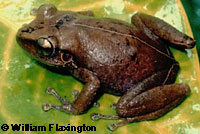 |
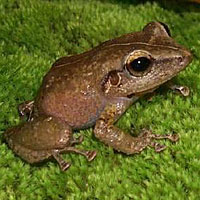 |
 Red Xs = counties in which this frog has Red Xs = counties in which this frog hasbeen found so far and may or may not be established. |
||||||
| Adult, Hawaii, Hawaii © William Flaxington |
Adult, U.S. Dept. of Agriculture | ||||||||
| A very small frog. Adults are roughly the size of a US quarter dollar coin. |
|||||||||
| Salamanders | |||||||||
Most salamanders in coastal Southern California are active on the surface only during the rainy season, typically October or November to May, and remain underground at other times. Salamander larvae remain active in water throughout the summer. They are most often seen in moist areas underneath objects on the ground. |
|||||||||
| California Newt Taricha torosa |
|||||||||
Video |
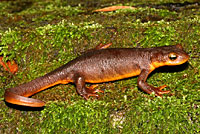 |
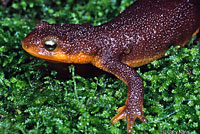 |
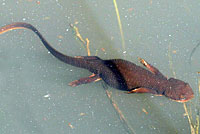 |
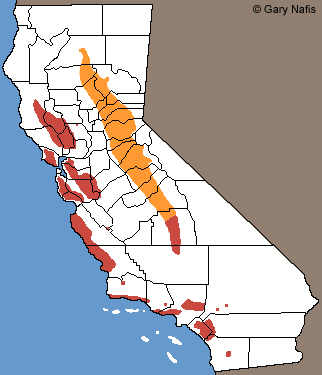 Range shown in Red Range shown in Red |
|||||
| Adults are about 3 to 3.5 inches long, not including the tail, and up to 8 inches with the tail. A stocky, medium-sized salamander with rough skin, no grooves on the sides between the legs, and dark eyes with a yellow patch on top. When living in the water during the breeding season, the skin becomes smooth and the tail is wider. Brown above, and pale orange or yellow below and on the head below the eyes. |
Diurnal. Common in some areas. Found in wet forests, woodlands, chaparral, and grasslands. Poisonous - Dangerous if Ingested |
Eats a variety of small invertebrates, including worms, snails, slugs, sow bugs, and insects, along with amphibian eggs and larvae, and sometimes small vertebrates. Females lay eggs in water between December and April, depending on location and habitat. Eggs hatch into larvae in 2 to 7 weeks. Larvae live in the water then transform into tiny newts and move onto land in several months. Often seen crawling on the ground in daylight during wet weather. |
|||||||
| Monterey Ensatina Ensatina eschscholtzii eschscholtzii |
|||||||||
Video |
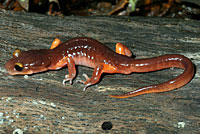 |
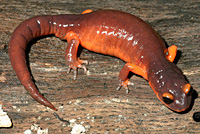 |
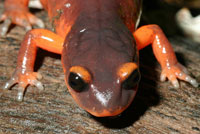 |
 Range shown in Purple Range shown in Purple |
|||||
| Adults are 1.5 to 3.5 inches long not including the tail, up to 6 inches long with the tail. A medium-sized salamander with smooth skin, dark eyes with a yellow patch on top, a tail that is constricted at the base, and visible grooves on the sides between the legs. Orange or brown in color with lighter orange marking the upper eyelids, tail, sides of the head, and base of the limbs. Young have many light speckles on the body. |
Nocturnal. Common in moist woodland areas. Found in moist shaded areas in forests, oak woodlands, mixed grassland, and chaparral. |
Eats a wide variety of invertebrates, including spiders, beetles, crickets, sowbugs, centipedes, millipedes, worms, snails, and termites. Females lay eggs in moist terrestrial places typically in April and May. Young hatch fully-formed, probably in the fall. Typically seen under rocks, logs, or other surface debris, but sometimes seen crossing roads on rainy nights. |
|||||||
| Large-blotched Ensatina Ensatina eschscholtzii klauberi |
|||||||||
Video |
 |
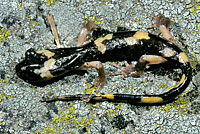 |
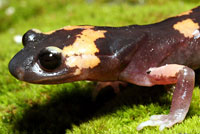 |
 Range shown in Dark Blue
Range shown in Dark Blue |
|||||
| Adults are 1.5 to 3.5 inches long not including the tail, up to 6 inches long with the tail. A medium-sized salamander with smooth skin, dark eyes with a yellow patch on top, a tail that is constricted at the base, and visible grooves on the sides between the legs. Orange or brown in color with lighter orange marking the upper eyelids, tail, sides of the head, and base of the limbs. Young have many light speckles on the body. |
Nocturnal. Common in moist woodland areas. Found in moist shaded areas in forests, oak woodlands, mixed grassland, and chaparral. Found only in the Peninsular Mountains. |
Eats a wide variety of invertebrates, including spiders, beetles, crickets, sow bugs, centipedes, millipedes, worms, snails, and termites. Females lay eggs in moist terrestrial places typically in April and May. Young hatch fully-formed, probably in the fall. Typically seen under rocks, logs, or other surface debris, but sometimes seen crossing roads on rainy nights. |
|||||||
| Arboreal Salamander Aneides lugubris |
|||||||||
Video |
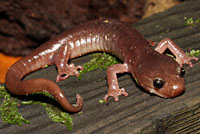 |
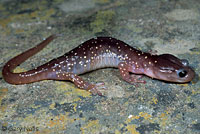 |
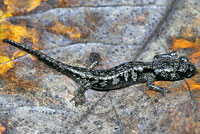 |
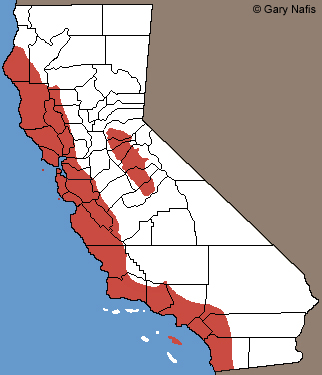 Range shown in Red Range shown in Red |
|||||
| Adult | Adult | Juvenile | |||||||
| Adults are about 2 to 4 inches long not including the tail, which can be up to 3 inches long. A medium-sized salamander with a large head and a tail that is often coiled. Adults are brown with small cream to yellow spots on the body that can be tiny or large in size, and dense or sparse. Young are black with light speckles. |
Nocturnal. Uncommon in our area. Found in moist places on land, mostly in oak woodlands, but also coastal dunes, forests, and urban areas. Often found in yards and gardens in suburban and urban areas. |
Eats a variety of small invertebrates, including millipedes, worms, snails, ants, termites, sow bugs, moths, and centipedes, and sometimes small salamanders. Females lay eggs in moist terrestrial places in late spring and early summer. Young hatch fully-formed in August and September. |
|||||||
| Southern California (Garden) Slender Salamander Batrachoseps major |
|||||||||
Video |
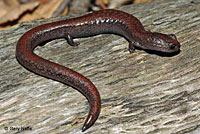 |
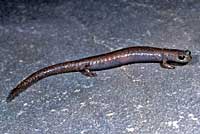 |
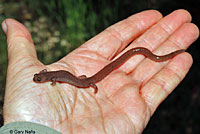 |
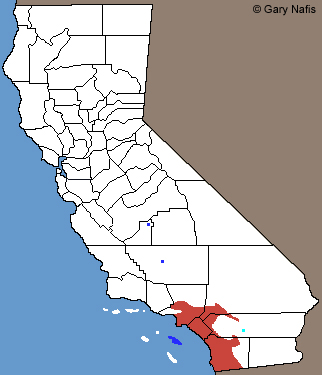 Range shown in Red Range shown in Red |
|||||
| Adults are 1.25 to 2.3 inches long, not including the tail, and typically they're about 4.5 inches including the tail. A small slim salamander, with relatively short limbs, a long slender body and a long tail, that is sometimes mistaken for a worm. Pale gray with a reddish color on the back and tail, although some are very dark. The belly is light in color. |
Nocturnal. Common. Found from the foothills of the Santa Monica, San Gabriel, San Bernardino, and transverse range Mountains to the coast, in a variety of habitats, including coastal sage scrub, oak woodland, mixed woodland, grassy areas, and suburban gardens. Often found in exposed areas that are very hot and dry outside of the rainy season. |
Eats a variety of small invertebrates, primarily small arthropods. Females lay eggs underground from November to January. Young hatch fully formed from January to April. |
|||||||
| How to differentiate a Black-bellied Slender Salamander from a Southern California Slender Salamander | |||||||||
| Black-bellied Slender Salamanders (below) and Southern California Slender Salamanders (above) overlap in range in Southern California and they are very similar in size and appearance. If you find a salamander in L.A. or Orange Counties, it could be either species. (If you find it high up in the San Gabriel Mountains, look here.) Ongoing surveys have found that both species occur throughout most of the L.A. Basin, as well as in the mountains and foothills. (Click the link above to learn how to tell them apart.) If you find a Black-bellied Slender Salamander in one of these counties, it will be helpful to those who are tracking their range in the area if you take some pictures and then report your observation at H.E.R.P. and iNaturalist. People there will also help you to confirm your ID as long as you photograph the underside. |
|||||||||
| Black-bellied Slender Salamander Batrachoseps nigriventris |
|||||||||
|
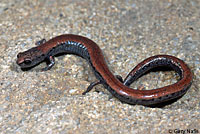 |
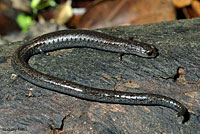 |
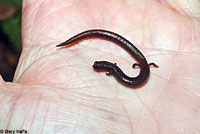 |
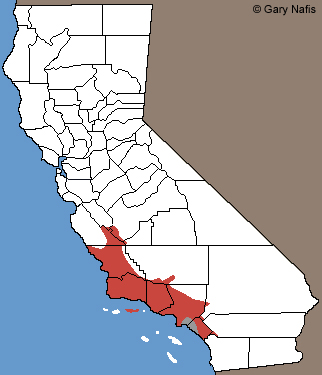 Range: Red and possibly Gray Range: Red and possibly Gray |
|||||
| Adults are 1.25 to almost 2 inches long, not including the tail. A small slim salamander, with relatively short limbs, a long slender body and a long tail, that is sometimes mistaken for a worm. Color is dark brown or black with a reddish, brown, or tan stripe on the top of the back. The belly is dark in color. |
Nocturnal. Uncommon, but very common where it does occur. Found only in the San Gabriel, Santa Monica, and Santa Ana Mountains, in oak woodlands, chaparral, grassland, next to streams, and mixed coniferous forest. |
Eats a variety of small invertebrates. Females lay eggs underground in winter. Young hatch fully formed in spring. |
|||||||
| San Gabriel Mountains Slender Salamander Batrachoseps gabrieli |
|||||||||
Video |
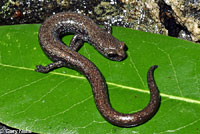 |
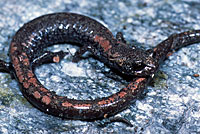 |
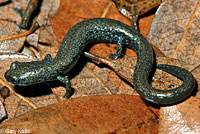 |
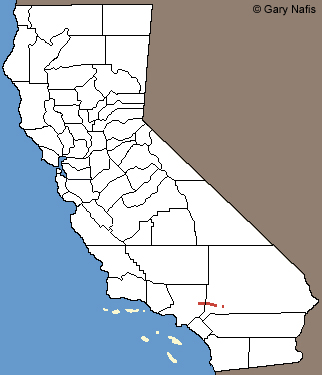 Range shown in Red Range shown in Red |
|||||
| Adults are 1.5 to 2 inches long, not including the tail. A small slim salamander, with relatively short limbs, a long slender body and a long tail, that is sometimes mistaken for a worm. Black with a copper to orange stripe on the back that breaks into patches on the tail. |
Nocturnal. Rare and localized. Found in extensive rock talus on forested slopes, often near a stream, at elevations from 2,800 to 7,800 ft. Known only from a few locations from San Gabriel Canyon in the San Gabriel Mountains to Waterman Canyon in the San Bernardino Mountains. |
Eats small invertebrates, including ants. Females lay eggs underground, probably after the first heavy fall rains. Young hatch fully formed. |
|||||||
Established Salamanders Not Native to California |
|||||||||
| Barred Tiger Salamander Ambystoma mavortium mavortium Not Native to California |
|||||||||
Video |
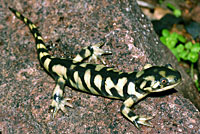 |
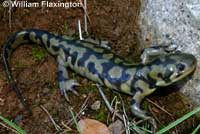 |
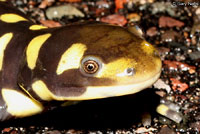 |
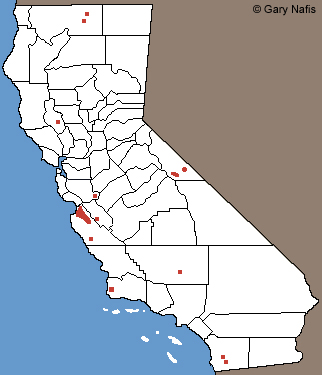 Some places where Tiger Salamanders have been recorded are shown in Red Some places where Tiger Salamanders have been recorded are shown in Red |
|||||
| Adults are 3 to 6.5 inches long, not including the tail. A large thick-bodied salamander with small eyes, and a wide, rounded snout. Greenish yellow with large dark bars across the upper body. |
Nocturnal. Rare and not native to our area. Adults spend most of their lives underground, but sometimes they are seen walking across roads on rainy nights. |
Eats anything they can catch and kill, mostly invertebrates, but lizards, mice, and small snakes are also eaten. Females migrate to water where they lay eggs after the rains begin. Eggs hatch in 8 to 9 days and the larvae live in the water until they transform into tiny salamanders in 10 or more weeks. |
|||||||
Return to the Top
© 2000 -

